It can be somewhat difficult to choose the correct flowers for your house or garden. It’s not just seasonality to consider; you also need to think about colour, sunlight, climate, and other factors.
With the help of our guide on flower varieties and meanings, you can choose the bouquet that best expresses your intentions.
1. Anise Hyssop

Scientific Name: Agastache foeniculum
It gives any scene the ideal vertical lines that are sometimes referred to as Hummingbirds Mint. When bruised, the leaves release an anise aroma, and they are occasionally added to herbal teas and jellies.
This perennial forms clumps and has vertical spikes that cling to lavender flower tubes. It is hardy, requires little maintenance, blooms for a long time from summer to autumn, and draws pollinators.
2. Brazilian Plume

Scientific Name: Justica carnea
This evergreen shrub, also called the Flamingo Flower, bears striking plumes of pink to scarlet flowers. They bloom from early summer to autumn, and they draw hummingbirds and butterflies. This plant, which can reach a height of six feet, likes partial to complete shade. They can be used as houseplants and look fantastic in containers.
3. Catmint

Scientific Name: Nepeta nervosa
Although not very well known, this catmint has remarkable blossoms that are more abundant than those of other catmints and worthy of any setting. From summertime to autumn, this flowering shrub produces dense spikes of blue to purple blooms. It looks great in containers, as cut flowers, or in front of sunny borders. Both cats and pollinators adore it.
4. Clematis

Scientific Name: Clematis
Members of the Ranunculaceae family include clematis. There are around 300 species and hundreds of hybrids among them, grouped into 12 major categories. You have an abundance of options, leaving you spoiled for choice.
Their shared characteristic is that they are long-flowering climbers. They bloom at different times of the year and in a variety of forms and hues. “Niobe,” “The President,” and “Nelly Moser” are a few RHS winners.
5. Common Evening Primrose

Scientific Name: Oenothera biennis
This is a striking yellow bloom with a bowl shape that is perched on a purple-tinged flower stalk. From early July to early autumn, they blossom abundantly.
Since the bloom opens in the evening and lasts until the next morning, they are known as evening primroses. The entire plant is edible, has a lemony aroma, and draws bees in the morning and night-flying moths at dusk.
6. Coneflower

Scientific Name: Echinacea
A common addition to most gardens is coneflowers. They are highly valued for their eye-catching cones that are encircled by a variety of vibrant, mostly drop-down petals.
They are really American plants and belong to the Asteraceae family, which also includes daisies and asters. Echinacea comes in a wide variety, and all of them have long, upright stalks that support their blossoms. They require little care and thrive when left alone.
7. Creeping Mahonia

Scientific Name: Mahonia repens
This award-winning evergreen shrub is also known as the Oregon grape. The plant bears racemes of fragrant, bright yellow flowers in the spring. They give place to blue-to-purple berries that resemble tiny grapes in the late summer. Up until winter, when it turns rusty, the leaves are still green. It’s therefore a great choice for year-round interest.
8. Cupcakes White

Scientific Name: Cosmos bipinnatus
This annual cosmos flower, which is semi-hardy, is recognized for its distinctive form. It has extraordinarily huge, solitary, five-inch-diameter, pure white flowers.
Because the petals have fused together to form a bowl around the yellow centre, it resembles a cupcake. A further layer of exquisite design is added by the light and feathery foliage. It can reach a height of four feet and requires full sun.
9. Egyptian Blue Water Lily

Scientific Name: Nymphaea caerulea
For those who enjoy gardening near water, here’s an aquatic perennial. The 16-inch-tall lily pads float on the water’s surface. The flower features thick yellow stamens surrounded by upright blue petals. It needs calm water and ample sun to bloom throughout the summer. This plant is very scarce and endangered, but it is still a beautiful accent.
10. English Rose

Scientific Name: Rosa
There are many options available to you when choosing a rose to grow because the genus Rosa has between 140 and 180 species. While some roses can be challenging to maintain, English roses bloom continuously throughout the season and yield an abundance of beautiful, fragrant blossoms on sturdy bushes.
For good growth, they require regular irrigation and soil that drains properly. They are attractive cutting flowers and ornamental woody perennials that come in a variety of colors.
11. False Bucks Beard

Scientific Name: Astilbe japonica
This plant species was recently brought to the state of New York from its native Japan. Its beauty has given rise to numerous cultivars, including “Montgomery” and “Rheinland.” Many of whom have received the RHS Garden Merit Award.
The Astilbe genus comprises eighteen hardy herbaceous perennial species that yield vivid, fluffy flower plumes. This flower looks great planted along the side of a pond.
12. Flaming Katy

Scientific Name: Kalanchoe blossfeldiana
Beautiful clusters of flowers rise above the thick, glossy leaves of this bushy, evergreen succulent. The scalloped leaves have a year-round, lovely appearance.
The blossoms can last up to six weeks, and it usually blooms twice a year. There are several colors: pink, orange, yellow, and red. When shielded from the frost, houseplants like Flaming Katy can be cultivated outside.
13. Floss Flower

Scientific Name: Ageratum houstonianum
Due to its autumn blooms that begin in mid-summer, ageratum means “long-lived” in Greek. This hardy annual is hardy in zones 2 through 12, as it is one of the few that can withstand some shade.
Bi-colour, white, pink, red, blue, lavender, and purple are among the colors. For mass planting, borders, beds, and mixed pots, floss flowers are an excellent option. Don’t let them dry out; they are easy to grow.
14. Forget-Me-Not

Scientific Name: Myosotis sylvatica
This well-known, transient perennial has tiny, blue flowers with yellow or white eyes that are occasionally pink or white. They have abundant blooms from spring through summer, and everyone enjoys their nectar and pollen. Low, fluffy mounds of semi-evergreen leaves are formed by the foliage. It looks fantastic beneath other flowers like roses or tulips.
15. Frangipani

Scientific Name: Plumeria rubra
This exotic flower has a four-inch-wide yellow centre and is spiral-shaped, white, crimson, or pink in colour. It is also quite fragrant. They can withstand intense temperatures and bloom year-round in tropical regions. A deciduous shrub with leathery foliage supports blooms. Both adults and kids adore these, and they’re frequently used for leis or worn in hair.
16. Garden Peony

Scientific Name: Paeonia officinalis
Originally from southern Europe, it was brought to North America and is also referred to as the common peony. It was first cultivated for decorative purposes, then for therapeutic ones.
It is an herbaceous perennial that blooms in late spring, from deep red to pink. Apart from the garden peony, numerous more varieties are accessible. They last a long time and require little upkeep.
17. Gladioli

Scientific Name: Gladiolus
The flowers, which are also called sword lilies, emerge from symmetrical, spherical corms. The stems are multi-coloured and produce funnel-shaped flowers from the middle to the terminals.
There are numerous Gladioli groups available. Nevertheless, they all add vertical drama to any floral arrangement, border, bed, or container. Depending on the variety you select, they can withstand temperatures ranging from 5 to 11.
18. Great Bougainvillea

Scientific Name: Bougainvillea spectabilis
This South American native is a prickly, decorative shrub. It is an evergreen in damp areas and can reach heights of 40 feet. The flower is modest, but its amazing colour comes from the waxy bracts around it. Vibrant hues such as yellow, orange, red, magenta, pink, purple, or white are among them.
It is a great option for coastal gardens because of its high resilience to salt. Although it can be planted in hanging baskets in colder climates, it is hardy in zones 9 to 10.
19. Hibiscus

Scientific Name: Hibiscus
There are several hundred species in the Hibiscus genus, all of which are indigenous to tropical and subtropical areas of the world. The huge, exotic blossoms include conspicuous stamens and a wide spectrum of colors.
This genus, sometimes called Rose Mallow, includes woody shrubs, small trees, and both annual and perennial plants. Some hibiscus plants undergo colour changes over time.
20. Hydrangea

Scientific Scientific Name: Hydrangea arborescens
Native to the Eastern United States, this kind of hydrangea blooms abundantly from early summer until autumn. The enormous flower-shaped domes, which are filled with hundreds of small blooms, open up lime-green and eventually turn creamy-white.
The broad, deciduous shrubs green leaves eventually turn a buttery golden in the autumn. Adding a lot of colour to your garden all year round.
21. Japanese Anemone

Scientific Name: Anemone hupehensis
This flower, which belongs to the buttercup family, won an RHS prize. It facilitates the change of seasons by blooming from late summer to autumn. It bears large clusters of double-deep pink or white blooms in the shape of cups.
One of the perennials with the longest blooming seasons; it has a ring of gold stamens encircling the centre. It can reach a height of three feet and is either a complete or partial sun lover.
22. Kings Mantle

Scientific Name: Thunbergia erecta
The Kings Mantle is the ideal choice if you want to give your landscape a hint of nobility. This plant grows straight and can reach a height of two meters.
It bears huge violet blooms with a golden centre. Hummingbirds, bees, and butterflies find them attractive as they bloom from summer to autumn. The Bush Clock Vine is another name for it.
23. Larkspur

Scientific Name: Delphinium
In the genus Delphinium, there are about 300 species. Known by most as larkspur, these perennial flowers are renowned for their colourful bloom spikes. Shades of purple, blue, pink, and white are all present in blooms.
Some grow as high as six feet; thus, they are popular in cottage gardens or among those seeking architectural height. Although many gardeners find them challenging, they can be a favourite for those who live in hot, dry conditions.
24. Liverleaf

Scientific Name: Hepatica nobilis
This is a little woodland plant that is evergreen. They can also be white or lavender, although they usually bloom a lovely blue. These blooms resemble daisies and offer a striking contrast between their yellow centre and white stamens. These look fantastic in containers or in front of any border or edging.
25. Love Lies Bleeding

Scientific Name: Amaranthus caudatus
Famous for its distinctive long tassel-like racemes of little corally-crimson flowers that contrast with the huge green leaves, this beautiful flower is well-known.
The flower tubes, also called cattails, are equally long. The plant can reach a height of eight feet, which can be used as an architectural element or as a rear border. It prefers full sun and moist but well-drained soil, and it is hardy in zones 2 through 11.
26. Meadowsweet

Scientific Name: Filipendula ulmaria
This herbaceous perennial plant, often called Queen of the Meadow, is typically found in moist meadows. The delicate, creamy-white flowers of this shrub are arranged in close clusters.
They draw a variety of pollinators, including bees, and bloom from summer to autumn. They are also quite fragrant. It thrives in gardens that are moist, by streams, or in water gardens.
27. Miss Willmotts Ghost

Scientific Name: Eryngium giganteum
This unusual-looking flowering plant looks amazing when juxtaposed with other vibrantly coloured flowers. Packed closely within the egg-shaped flower head are tiny blossoms that start off pale green and eventually turn steel-blue. Any scene is given a ghostly feel by the spikey silver-to-white bracts surrounding the head. It is resistant to drought and is an RHS winner.
28. Oriental Lily

Scientific Name: Lilium orientalis
The most well-known feature of oriental lilies is their extremely fragrant blooms, which appear in late summer and provide a final burst of vivid colour. White, pink, red, yellow, and some with patterns, dots, and bicolour are among the colours. Because they are so simple to grow, oriental lilies are widely used in many hardiness zones.
The fragrance is loved by most gardeners, but cats should avoid this plant, according to the FDA. They are easy to grow and thrive in direct sunlight. Due to its widespread popularity, a wide variety of species and cultivars are available.
29. Pincushion Flower

Scientific Name: Scabiosa atropurpurea
This is an annual or short-lived, bushy perennial that blooms in deeply coloured flowers that resemble pincushion shapes. The feathery petals on the outside of the burgundy flowers increase in colour as they approach the centre. They bloom from spring to autumn and are two inches across. They are hardy in zones 4 through 11 and thrive in full sun.
30. Queen of the Night

Scientific Name: Epiphyllum oxypetalum
This unusual bloom, sometimes known as the orchid cactus, puts on a breathtaking show at night. With spikey bracts in the backdrop, the white blooms, which can reach a width of 12 inches, are incredibly fragrant. They are often only open for one night, giving you and your guests a show.
It climbs nicely up trees and walls and may be planted outdoors in zones 10 to 11. If it receives enough fertilizer, it doesn’t care what the conditions are.
31. Red Spider Lily

Scientific Name: Lycoris radiata
This perennial bulbous plant bears umbels, or clusters, of four to six coral-red blooms. The stamens are incredibly long, and the petals are curled, giving them an exquisite eyelash look. They provide you with a final splash of summer colour when they bloom in late summer or early autumn.
It can reach a height of 24 inches. When arranged in clusters of three to five or in large quantities, they provide an eye-catching coral carpet effect.
32. Satin Flower
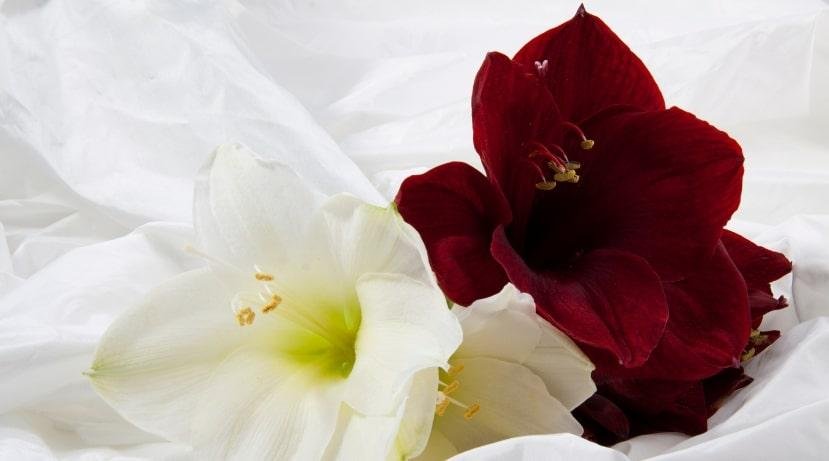
Scientific Name: Clarkia amoena
It is indigenous to coastal northwest California and is also referred to as the Farewell to spring. It’s an annual that has racemes of satiny, cup-shaped blooms. Lavender, scarlet, pink, or lilac are among the possible hues; each petal typically has a blotch of contrasting colour at its base.
They require adequate air circulation to blossom, which occurs from late spring to midsummer. They are hardy in zones 2 through 11 and make excellent borders and containers.
33. Snapdragon

Scientific Name: Antirrhinum majus
The showy flower’s reaction of snapping its lips open when its throat is pressed is where the name comes from. Both kids and enthusiastic gardeners love this vibrant flower.
Snapdragons bloom from spring to autumn and are a short-lived perennial that is usually planted as an annual. They bloom in a wide range of vibrant colours and have a pleasant scent. Hummingbirds and bumblebees adore them.
34. Snow in Summer

Scientific Name: Cerastium tomentosum
This short-lived perennial, sometimes called the Jerusalem Star, blooms a dense groundcover of snow-white flowers in the summer. The foliage is silver to grey in colour, and the blooms are star-shaped with notched edges. Because of its cascading effect, this low-growing plant looks fantastic anywhere you need ground cover, including on stone walls and in rock gardens.
35. Sweet Pea

Scientific Name: Lathyrus odoratus
The wonderfully fragrant blossoms of this bushy deciduous shrub make it highly valued. From late winter to early spring, this plant bears short-tubed, white-to-cream blooms with long stamens arranged in a line along each stem.
Growing up to 10 feet in height and width, it’s perfect for use as a screen or backdrop. Just make sure you have the patience to enjoy its lovely blossoms and winter scent.
36. Virginia Sweetspire

Scientific Name: Itea virginica
This shrub is erect and rounded, with spikes of bottlebrush covered in star-shaped blooms. The blooms are numerous, creamy to white in colour, and have a faint scent. Because of its low maintenance requirements and extended seasonal interest, it is a popular choice with gardeners and pollinators of all kinds.
This plant can reach a height of ten feet and looks fantastic as a hedge or at the back of borders. It thrives in damp soils next to streams and is adaptable.
37. Water Lily

Scientific Name: Nymphaea
There are about 36 species in the genus Nymphaea, which includes both hardy and delicate aquatic flowering plants. There are two varieties of water lilies, each with unique characteristics: Hardy Water Lilies and Tropical Water Lilies.
They help maintain the health of your water garden in addition to being a rainbow of hues and forms. They accomplish this by lowering the amount of algae in the water, giving fish cover, absorbing nutrients to maintain the water clear, and many other ways.
38. Wishbone Flower

Scientific Name: Torenia fournieri
This bushy annual prefers locations in shade. It yields an abundance of pale lavender flowers with dark purple rims that resemble two-lipped trumpets. Its common name comes from the wishbone-shaped arrangement of the golden stamens.
They bloom abundantly from the beginning of June until the first frosts. These blooms look fantastic in window boxes, containers, and rock gardens.
39. African Marigold

Scientific Name: Tagetes erecta
This bushy annual, sometimes called the Big Marigold, is highly valued for its huge double flowers. Each blossom comes in orange, yellow, and white hues and is two to four inches across. They require little care to flourish, and they bloom for a long time, from early summer until the first frost. They are perfect for patio pots, beds, and borders.
40. American Lotus

Scientific Name: Nelumbo lutea
This may not be as well-known as the Sacred Lotus, which is grown more frequently. However, the pristine white petals and yellow centre of these blooms give them a blanket of elegance. They are amazing to see and can reach a diameter of 12 inches. It’s a marginal aquatic perennial with big leaves that resemble umbrellas.
41. Bachelors Button

Scientific Name: Centaurea cyanus
Known by another name, cornflower, this charming tiny flower has colors reminiscent of daisies—bright pink, purple, maroon, and blue. These are annuals with late spring through late summer blooms.
They often have two heads and are carried on long stems. Hardy in zones 2 through 11, these blooms attract butterflies and prefer full sun to partial shade. Perfect for cutting, borders, bedding, and containers.
42. Bee Balm Flower

Scientific Name: Monarda didyma
This plant, which belongs to the mint family, has a pleasant aroma that many liken to bergamot orange. Of the several species of Monarda, sixteen are indigenous to North America. They are quite popular among gardeners since they are among the most eye-catching summer perennials.
Red-tinged bracts surround scarlet-red blooms. Their towering stems and seed heads add to their winter appeal, and they can bloom for up to six weeks.
43. Beauty Bush
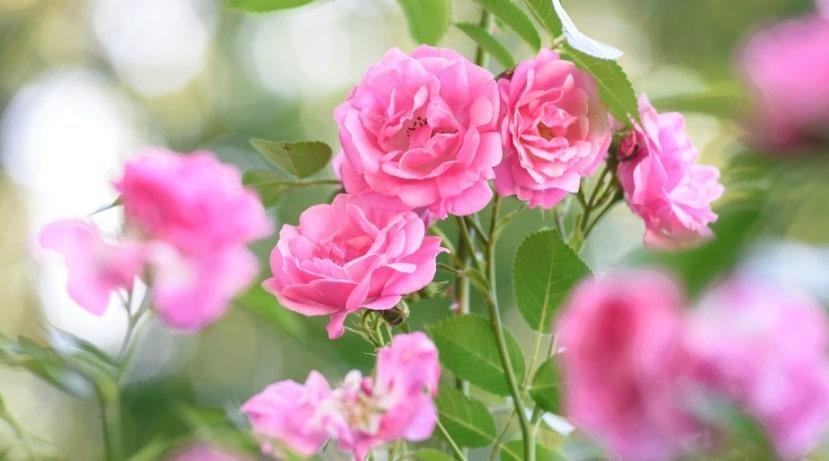
Scientific Name: Kolkwitzia amabilis
This deciduous shrub is erect and has a vase-like form. With a maximum height of 10 feet, it’s ideal for backgrounds or hedges. It blooms copiously for several weeks in small, light-pink flowers from mid- to late spring. Birds adore the capsule-shaped fruits that follow blooms. The bark then peels, offering even more seasonal intrigue.
44. Bleeding Heart
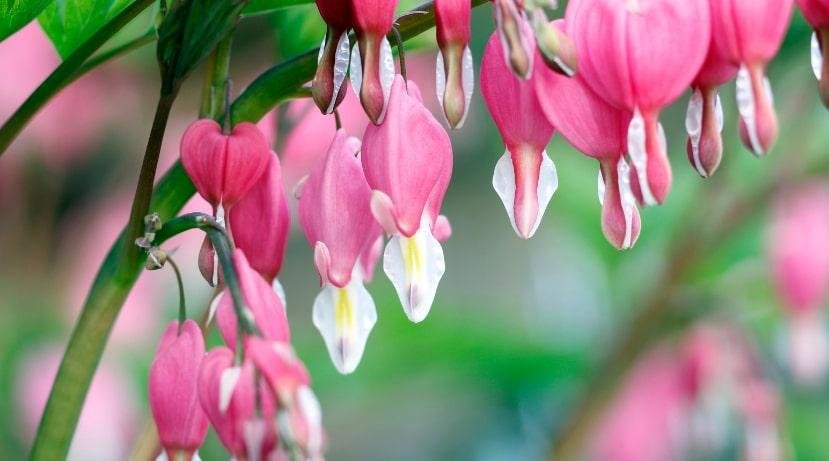
Scientific Name: Dicentra spectabilis
This dainty, herbaceous perennial is an exquisite old favorite. The arched stems have projecting white petals and are adorned with lockets of pink flowers. Thus, the term “bleeding heart.” They tend to vanish in the middle of summer, having barely bloomed for four or six weeks in late spring. They work well for woodland gardens, shaded borders, and under planting shrubs and roses.
45. Cardinal Flower

Scientific Name: Lobelia cardinalis
This bloom adds a great touch to landscapes in the late summer. It is a perennial plant that has spikes of cardinal red, bilobed flowers. They give architectural flair to any garden and can reach a height of four feet. Their dramatic and colorful look makes them worth the wait, even if they are fleeting. They are also known as bog sage because they prefer moist soils.
46. Creeping Phlox

Scientific Name: Phlox subulata
This well-liked perennial evergreen serves as a vivid ground cover. It creates a vibrant carpet of blooms with an abundance of star-shaped flowers in shades of pink, purple, or white lasting around four weeks from spring to summer.
It grows natively in rocky, arid environments and is indigenous to eastern and central America. Phlox is low-maintenance, hardy in zones 3 through 9, and a favorite among pollinators.
47. Common Zinnia
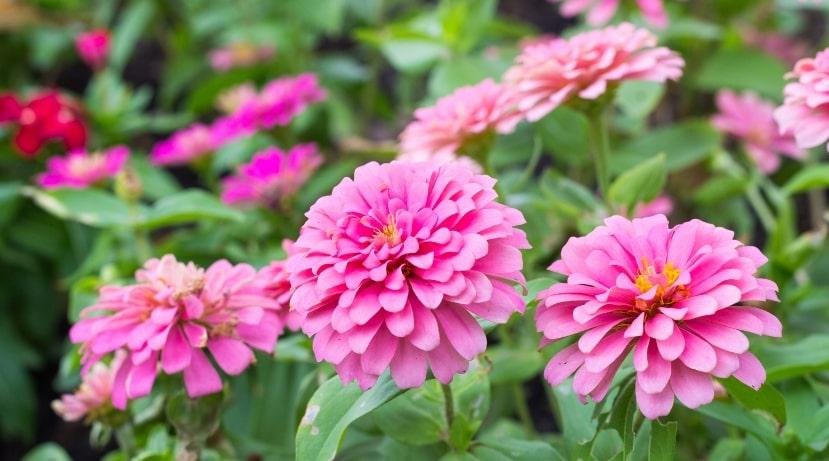
Scientific Name: Zinnia Elegans
In any garden, these vividly colored blossoms are a sight to see. Zinnias come in a variety of colors, forms, and heights and they bloom from early summer until the first frost. Their petals are arranged in rows, revealing the centre of the flower as they reach up to three feet in height.
Although they are simple to produce, avoid crowding them because they require air movement. Some notable varieties are “Pop Art White and Red,” “Macarenia,” and “Queeny Lime Orange.”
48. Crown of Thorns
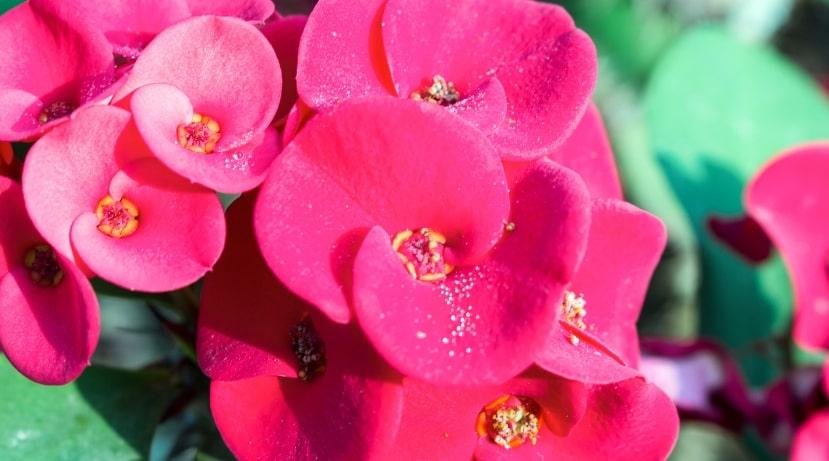
Scientific Name: Euphorbia milii
This is an evergreen shrub that spreads widely and is ornamented with tiny yellow blooms enclosed in red bracts that mimic petals. Bright green leaves and long, sharp black thorns cover the succulent branches.
The plant’s stems were used to make the crown of thorns that Jesus Christ wore, according to mythology. Generating conversation about it in any garden. It is quite spectacular and blooms all year long.
49. Dahlias

Scientific Name: Dahlia
There is a Dahlia for every gardener’s needs and preferences, thanks to the thousands of varieties and 42 species of Dahlias. Dahlias can be divided into eight types according to the size and form of the flower.
Blooms come in every colour you can think of, with some having stripes or points, and range in diameter from 2 to 14 inches. They are hardy in zones 8 through 11, grow well in full sun, and are the national flower of Mexico. They bloom from June to autumn and are herbaceous perennials.
50. Flowering Quince

Scientific Name: Chaenomeles speciosa
This deciduous shrub with several stems bears lovely flowers that might be red, orange, pink, or white in hue. They can blossom for up to 14 days in late winter or early spring, after which yellow-green fruits that are used to make preserves and jellies follow. Growing up to 10 feet tall, this shrub has a thorny habit and an untidy appearance. Making it the perfect option for a plant barrier.
51. Fuchsias
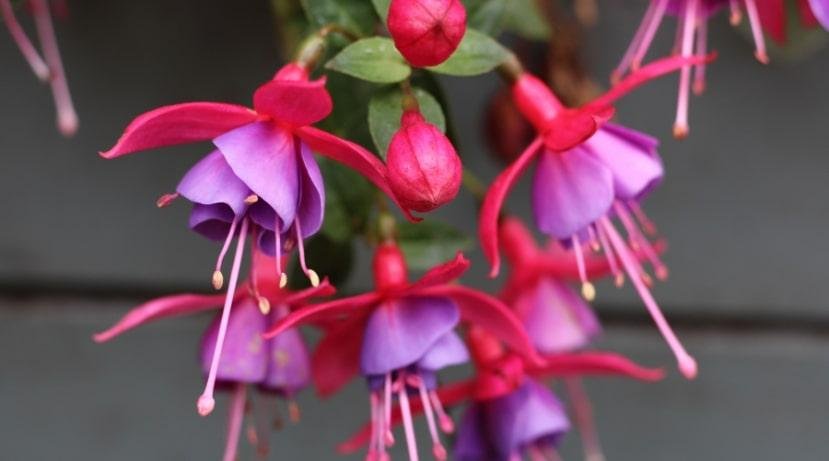
Scientific Name: Fuchsia
Beautiful flowering shrubs or tiny trees in the Fuchsia genus can be found. There are thousands of cultivars and about 110 species to select from. They are a favourite in most gardens since they have some of the most beautiful summer blooms.
The blossoms, which are frequently two-toned, hang in clusters and are stunning in tones of pink, purple, peach, and white. They are perfect for hanging baskets or easy-flowering hedges because they grow in a variety of ways.
52. Gillyflower

Scientific Name: Matthiola incana
This belongs to the Brassicaceae family, which also includes cabbages, and is sometimes referred to as vintage stock. These transient perennials, on the other hand, are significantly more attractive and produce upright clusters of fragrant, eye-catching flowers.
Their rich aroma and vertical drama make them a florist’s favourites. They come in a variety of hues. They also look amazing in containers and borders. Plant them close enough to each other to smell their delicious perfume.
53. Globe Amaranth

Scientific Name: Gomphrena globose
The annual tropical plant Globe Amaranth is native to Central America and needs full light. It consistently blooms from the summer into the autumn.
The long-lasting blossoms have a pom-pom shape and are vividly coloured in several shades. Hummingbirds, butterflies, and swallowtails are drawn to their enduring dried arrangements, which are highly valued.
54. Globe Thistle

Scientific Name: Echinops bannaticus
The sunflower family includes the globe thistle, or Echinops. This perennial forms clumps and has blue-to-gray heads that resemble globes. They germinate readily and grow from mid- to late-summer. They are beautiful flowers that look wonderful in all kinds of gardens, even low-maintenance ones. Which makes them perfect for novice gardeners?
55. Grape Hyacinth
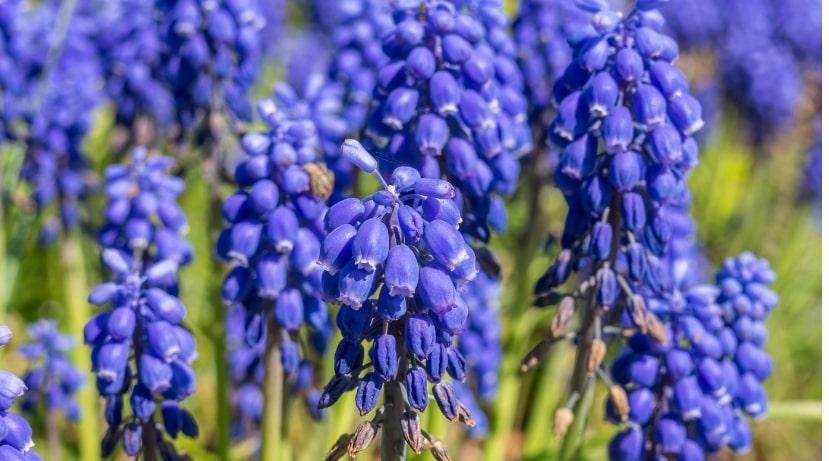
Scientific Name: Muscari armeniacum
This multi-award-winning variety of grape hyacinth is prized for its versatility, ease of growth, and resistance to winter. It bears delicate cobalt-blue grape-shaped clusters of blooms atop slender green stems.
They grow to a height of eight inches and bloom in mid- to late spring. When planted in huge clusters or scattered amid flowers of different hues, they look amazing.
56. Harlequin Flower

Scientific Name: Sparaxis tricolor
These striking showy blossoms, with their vibrant colours and patterns, provide any garden with beautiful pops of colour. These are cormous perennials that grow wiry stalks on which up to five open flowers in the shape of stars are carried.
The common name “harlequin” comes from the hues of red, yellow, orange, lavender, or white with a black ring around a yellow centre. They require little maintenance and work well in direct sunlight.
57. Honeycup

Scientific Name: Zenobia pulverulenta
This shrub has an upright growth habit and is semi-evergreen. Elegantly curved crimson stems support waxy green to grey leaves that change to reddish-yellow in the autumn.
It produces clusters of white, bell-shaped, anise-scented flowers in the spring. It is a slow-growing plant that thrives near streams and enjoys damp soils. It is frequently mistaken for the lily of the valley.
58. Italian Asters
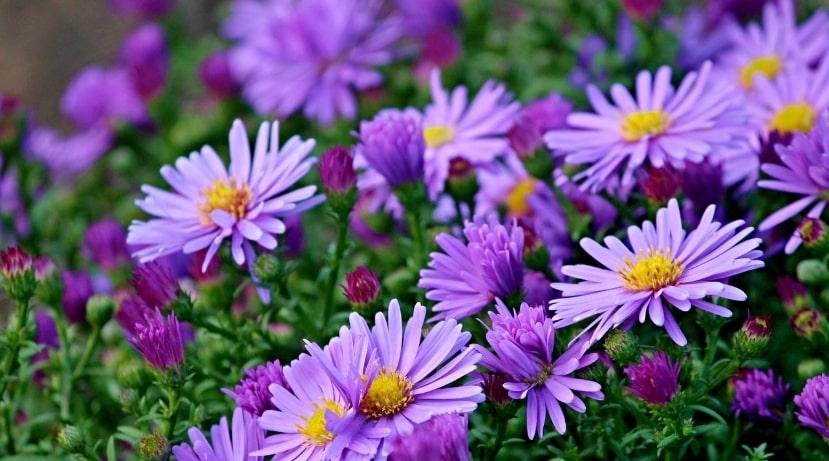
Scientific Name: Aster amellus
This aster is well known for being among the first to bloom late in the blooming season, adding vibrant flashes of colour. Lavender-to-blue flowers have centres of brilliant golden colour. These compact perennials have a low growth rate and look fantastic in rock gardens and borders. These blossoms tolerate drought well and attract bees and butterflies.
59. Lacespine Pincushion Cactus

Scientific Name: Mammillaria lasiacantha
Its spines, which range in colour from white to pale pink and give the appearance of lace, also go by the name “Golf Ball Cactus.” It yields pink and white flowers, with black rays encircling dark yellow stamens in the centre.
Even though they resemble spikey cacti, the beautiful blossoms and lace texture make them a perfect accent to any garden. Starting to flower in February, it is one of the first cacti to do so.
60. Lilac Tasselflower
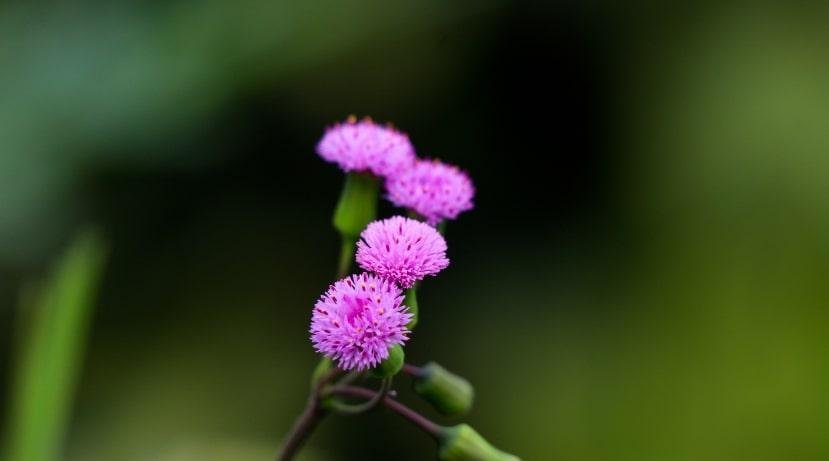
Scientific Name: Emilia sonchifolia
This tropical annual herb is native to Asia and is sometimes referred to as Cupid’s Shaving Brush. A single plant can reach a height of 16 inches and bear several pink or lilac flower heads. With 30 to 60 florets per head, they have an urn-like form.
This lovely flower looks great when planted in borders and beds. Just be cautious not to plant it close to kitchen gardens, as it may have a detrimental effect on crop output.
61. Madeiran Squill

Scientific Name: Scilla madeirensis
This unusual bulbous perennial is indigenous to Madeira Island. When most other perennials are wrapping up for the year, this squill produces a cone full of amethyst blooms in late autumn or early January.
It’s roughly the size of an amaryllis, filled with small flowers capped with yellow dots. The leaves are plump and succulent. When it comes to ideal growing circumstances, this gorgeous plant can be particular.
62. Meadow Rue

Scientific Name: Thalictrum aquilegifolium
This perennial form clumps and often reaches a height of three feet. It is highly valued for the thick panicles of fluffy blooms along with its delicate, blue-green leaves. Flowers appear as delicate pink, purple, or white blooms. They are easily grown and have a few weeks of late-spring blooming.
63. Million Bells

Scientific Name: Calibrachoa
The trendiest plant for the garden is Calibration, sometimes referred to as Million Bells. The flowers, which are one inch across, are coloured differently; occasionally, they have two tones, patterns, stripes, or double blossoms. They’re sometimes likened to petunias and are excellent trailing plants for hanging baskets and containers. Primarily, it is planted as an annual.
64. Mock Orange

Scientific Name: Philadelphus coronarius
This shrub is deciduous and has stiff, straight branches. Blooms begin to appear in late April as thick clusters of cup-shaped flowers. The flowers have a strong aroma and are beautifully white, with yellow stamens. When fully grown, it can reach a height of 12 feet and yield hundreds of flowers at a time. Consequently, it is a fantastic addition to any landscape.
65. Oleander

Scientific Name: Nerium oleander
This is a tiny tree or flowering shrub that peaks in the summer and produces beautiful blossoms all year. At the end of each branch, it bears clusters of five-petaled white, red, or pink flowers.
They occasionally release a strong smell, but typically not. It is a great choice for the rear of gardens because it may reach a height of 20 feet. Van Gogh loved oleander, and he frequently included them in his paintings.
66. Ornamental Onion

Scientific Name: Alliums giganteum
Among the tallest alliums, this one has a ball-shaped cluster of tiny purple flowers that resemble stars at the apex of each stem. Their long-lasting and gorgeous blooms appear in late spring or early summer. They look fantastic when planted in groups of ten or more, or mixed in with more delicately textured plants, to create enormous sweeping drifts. It also attracts butterflies.
67. Pasque Flower
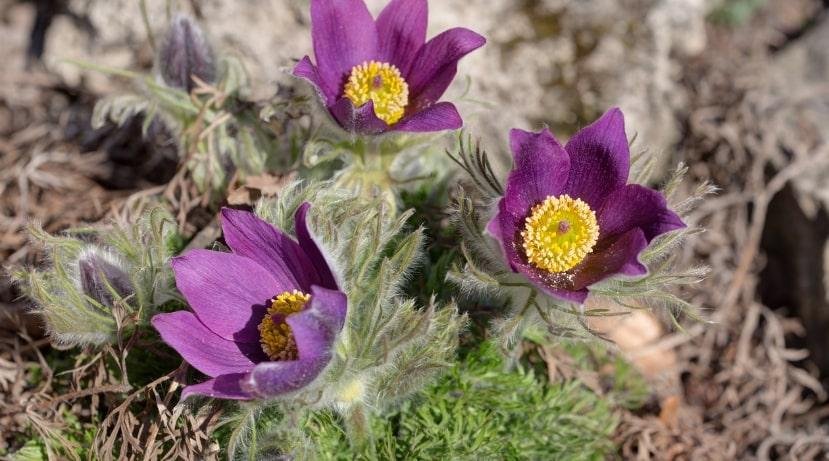
Scientific Name: Pulsatilla vulgaris
Pasque flowers are enormous, spectacular perennials that bloom in early spring. The blossoms are two to three inches wide. Up to thirty bell-shaped flowers can be produced by one plant.
With a bright yellow centre filled with fluffy filaments, the colors vary from purple to blue. Their fern-like, velvety foliage makes them perfect for the front of borders and rock gardens.
68. Persian Buttercup

Scientific Name: Ranunculus asiaticus
Both gardeners and florists adore this incredibly graceful flower. The plant, which can be annual or perennial, bears blooms in a variety of colors, such as white, orange, pink, yellow, and red.
The petals are made of numerous layers and are as thin as pancake paper. They are perched on robust stems and abundant foliage. They favour milder seasons and bloom for around six weeks in the early summer.
69. Poppy Anemone

Scientific Name: Anemone coronaria
There are many other shades of red, pink, purple, blue, white, or bi-colored blossoms that resemble poppies. They can have one or two flowers, and their black centers are decorated with fluffy stamens. Poppy anemones are beautiful cut flowers that bloom from mid- to late-spring. They return year after year and are simple to establish.
70. Queen of the Night

Scientific Name: Epiphyllum oxypetalum
This unusual bloom, sometimes known as the orchid cactus, puts on a breathtaking show at night. With spikey bracts in the backdrop, the white blooms, which can reach a width of 12 inches, are incredibly fragrant.
They are often only open for one night, giving you and your guests a show. It climbs nicely up trees and walls and may be planted outdoors in zones 10 to 11. If it receives enough fertilizer, it doesn’t care what the conditions are.
71. Red Campion

Scientific Name: Silene dioica
This perennial wildflower, also called Adders Flower, is semi-evergreen and grows in damp meadows. It produces a profusion of lovely pink blooms with a white throat and clusters of downy foliage. Gardeners love them for their low maintenance and aesthetic appeal. They look beautiful in beds and borders and prefer full sun to mild shade.
72. Rosy Garlic

Scientific Name: Allium roseum
This graceful perennial, also called ornamental garlic, has a subtle yet distinct onion scent. It yields clusters of pale to deep pink, star-shaped blooms on tall stalks.
Reaching a height of up to 16 inches, it towers over lush green foliage. When this flower is planted in groups of at least 20, it looks amazing. It draws butterflies and grows readily in direct sunlight.
73. Shooting Star

Scientific Name: Dodecatheon media
This stunning flower, often called the Pride of Ohio, has huge umbels that hold eight to twenty blooms each. They have five upward-facing petals and come in three colour options: deep pink, light pink, or white.
The noticeable stamens point downward like an umbrella blown by the wind. They are herbaceous perennials that bloom for about a month in late spring. Group these to create a stunning show.
74. Showy Speedwell

Scientific Name: Hebe speciosa
This exotic flower with spikes is very well-known for its beautiful show. Although it originated in New Zealand, the US is seeing a rise in its popularity. Shiny and evergreen, the leaves grow to shrub-like heights. It bears tubes of compactly arranged tiny flowers, each with two elongated stamens that give the plant a whiskery look.
75. Snowdrop

Scientific Name: Galanthus nivalis
A common flower in many gardens is this one. It is among the first to blossom, and in late winter, the leaf frequently shows through snowfall. They are tiny perennial bulbs that bloom in the early spring and give off a light scent.
Each petal of the white blooms has a tiny green dot that nods. They can reach a height of 10 inches and look fantastic planted anywhere, but especially when arranged in broad drifts or big groupings. In zones three through eight, it is hardy.
76. Spider Flower

Scientific Name: Cleome hassleriana
This annual grows quickly and produces big, airy clusters of tiny blooms. Their long, spiky stamens give them a spider-like appearance. They are white, pink, and purple in colour and very fragrant. Dried seed heads give birds food in the winter, and spider flowers bloom from summer until the first frost. They require little upkeep and seem best in clusters of six or more.
77. Star Jasmine

Scientific Name: Trachelospermum jasminoides
This shrub is evergreen and covers practically all of its foliage with a profusion of star-shaped blooms. The leaves are oval-shaped and have a glossy, black appearance.
It is used as a climbing option to cover walls and fences and to make sectional hedges because of its prolific growth. It can reach a height of 20 feet with support. It’s known as a great choice for inexperienced gardeners, and the flowers smell amazing.
78. Stonecrop
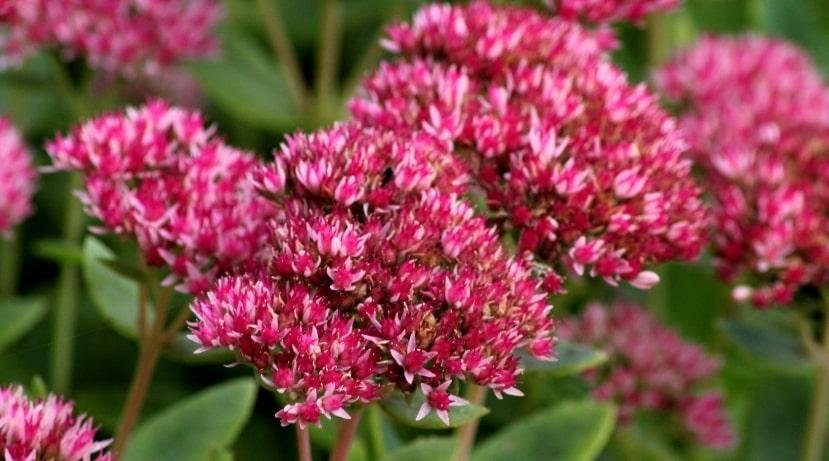
Scientific Name: Sedum
The colors, sizes, and habits of Sedums vary greatly among their many varieties. Depending on what your garden needs, you can choose from three popular types that are classified as erect, creeping, or mat-forming. All of them are perennials that yield clusters of small blooms that resemble broccoli.
Bees and butterflies are drawn to seasonal interest, which can last up to six months. Colours tend to get more intense when the temperature becomes colder. Seek out exceptional cultivars like “Purple Emperor,” “Class Act,” “Matron,” and “Brilliant.”
79. Sunshine Mimosa

Scientific Name: Mimosa strigillosa
This eye-catching blooming perennial, also called the Powder Puff Flower, is a mat-forming plant. It bears lavender to pink ball-shaped flowers that bloom from spring until late summer.
Every garden is made more vibrant and exciting by the contrasting yellow tips on the stamens. All US states bordering the Gulf of Mexico are home to this native plant, which thrives in full sun and sandy soil.
80. Tender Geraniums

Scientific Name: Pelargonium
The “Hardy Geraniums,” which are also members of the genus Geranium, should not be confused with these. When gardening enthusiasts think of vibrant bedding flowers, they usually think of tender geraniums. They are easy to maintain and have a lengthy flowering season.
Generally speaking, they are red, orange, and white, while other colors are also an option. There are three varieties of tender geraniums: zonal, regal, and angel. They are usually planted as annuals.
81. Violet Slipper Flower

Scientific Name: Jovellana violacea
This herbaceous perennial has an erect shape and is semi-evergreen. The flowers steal the show; however, they do have serrated leaves arranged in opposite pairs.
Violet slippers are bell-shaped, two-lipped flowers that nod and resemble slippers. Their flowers often have a golden throat and a delicate purple colour with tiny purple dots. It enhances the visual effect with flowers all summer long.
82. Wavyleaf Sea Lavender

Scientific Name: Limonium sinuatum
This is a short-lived, erect-growing perennial that is occasionally grown as an annual. On winged stalks, it bears dense clusters of tiny, funnel-shaped blooms. They are available in shades of lavender, pink, violet, rose, yellow, orange, and white and they bloom from the summer to the beginning of autumn.
Because they hold their colour well, they are among the most widely used options for dried bouquets. It is perfect for gardens by the shore because of its excellent resilience to salt.
83. Wild Pansy

Scientific Name: Viola tricolor
It also goes by the name Johnny Jump Up and yields one-inch-diameter, three-toned blooms. The flowers, which usually have rich purple, lilac, and yellow petals with veins and spots, are borne atop slender, spreading stems and bushy foliage.
They spread swiftly, like cooler climates, and bloom from spring to autumn. They look fantastic in containers, rock gardens, beds, and borders.
84. Yellow Jewelweed

Scientific Name: Impatiens pallida
This plant is highly valued for its unusually lovely blossoms. This leafy annual bears yellow pendant flowers with crimson flecks on them. They resemble delicate earrings since they are so small. They give gardens a last burst of colour from early summer until the first frost.
Touch-me-nots are another name for these blooms because the seed pods shoot a long way when they burst at even the slightest touch. Only moist gardens will be favourable to this plant.
85. Baby’s Breath
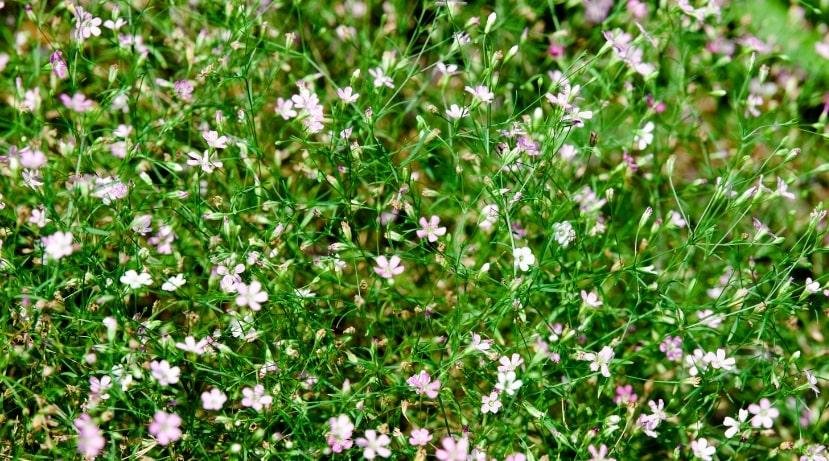
Scientific Name: Gypsophila paniculata
This choice is well-known for being favorites in the world of bouquets and cut flowers, but it also belongs in the garden. This perennial blooms in clouds of small pink or white flowers that contrast with most other flowers or look lovely on their own. It forms ornamental mounds up to three feet tall, and its long-lasting blossoms last until autumn.
86. Beeblossom

Scientific Name: Gaura lindheimeri
The natural regions of this perennial plant are Louisiana and Texas. It yields delicate branches that resemble grass and hold lovely flowers. Flowers resemble butterflies from a distance because they are white, often with pink undertones.
It blooms gradually from early summer to autumn, so you may take in weeks upon weeks of breathtaking displays. Mass plantings of this easy-to-maintain plant look fantastic.
87. Balloon Flower
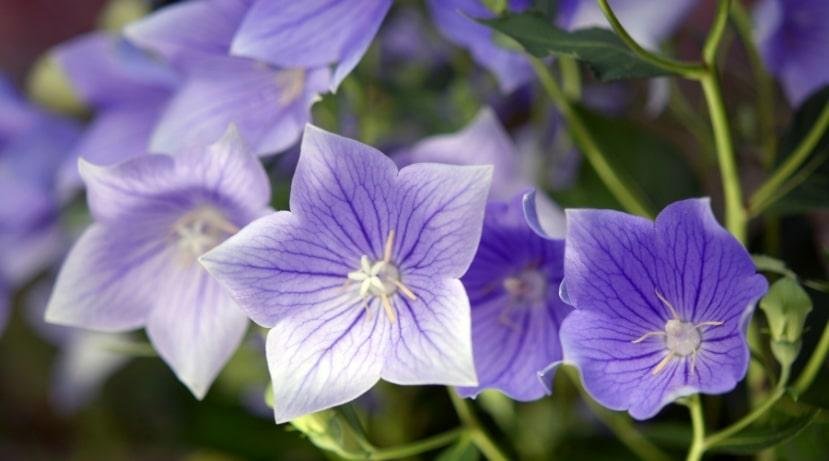
Scientific Name: Platycodon grandiflorus
Bell-shaped, deep blue or light pink flowers are produced in abundance by this herbaceous perennial flower. Balloon-like buds give rise to balloon-like flowers.
Just be careful not to pop them. Late April is when their stems sprout, so take care not to disturb them. They look great in beds, containers, and cottage gardens; for maximum impact, grow them in clusters.
88. Angels Fishing Rod

Scientific Name: Dierama pulcherrimum
Fairy Wand is another name for this lovely evergreen perennial that looks wonderful in any part of the garden. Especially along edges, walls, or over ponds where its arching stems are visually appealing.
For several weeks at the beginning of summer, bell-shaped white, pale pink, or magenta flowers are produced by the grass-like stems. They are reasonably easy to care for, although they require full light and excellent soil.
89. African Violet
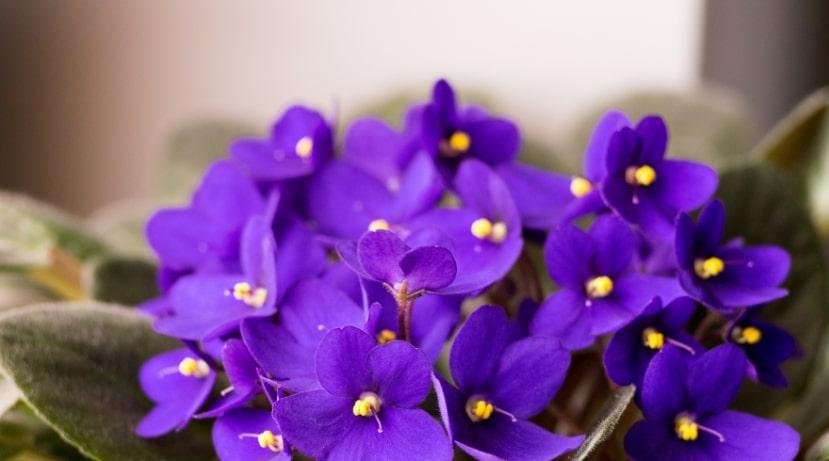
Scientific Name: Streptocarpus Saintpaulia
One of the most common plants for indoor gardens is the African Violet. The majority of species are found in mountains by nature, frequently hidden by other vegetation. They therefore need light and temperatures that are reasonable, both of which are easily discovered and controlled inside homes. However, because of how frightening their care can be, several indoor gardeners are reluctant to cultivate them.
These plants feature petals with a frilly or fringed texture, and they are available in nearly every colour. If they are in consistent, bright lighting, they will bloom almost every day. Usually green or variegated, the foliage has a faint, fuzzy texture.
90. Achillea Desert Eve Deep Rose

Scientific Name: Yarrow
This is one of the first yarrows to bloom and is part of the Desert Eve Series. This vibrant perennial herbaceous plant bears big clusters of vivid pink flowers. It boasts several weeks of heavy blooms in late spring, with fluffy yellow centers to each blossom. This fragrant, semi-evergreen flower blends well with most other flowers in any arrangement. Any natural or rustic garden needs yarrows since they are a favorite’s plant of butterflies.
91. American Wisteria

Scientific Name: Wisteria frutescens
American Wisteria is a strong climber that blooms from late spring to summer on twining branches. It produces delightfully fragrant clusters of drooping, pea-sized, lilac-colored flowers that are six inches long.
Chinese and Japanese kinds of wisteria cause more structural damage than American wisteria. It can reach a height of 30 feet and, once it reaches maturity, can become rather heavy, so it needs a sturdy structure to sustain itself.
92. Belladonna Lily

Scientific Name: Amaryllis belladonna
An award-winning amaryllis, sometimes called the Jersey Lily or Naked Ladies, is a bulbous perennial. It yields big clusters of tiny pink trumpet-shaped flowers with a throat that is both white and yellow. Both pollinators and humans find it to be incredibly beautiful, with curled anthers and a pleasant scent.
It offers a breathtaking spectacle for the autumn when it opens in the late summer and early autumn. It is simple to maintain and can reach a height of three feet.
93. Black-Eyed Susan

Scientific Name: Rudbeckia fulgida
This flower has several different species. They can produce up to 80 golden-yellow, starburst-shaped blooms per plant, demonstrating their extreme floriferousness.
They have a black core cone and can get up to 2 ½ inches broad. Rudbeckia, often known as Black-Eyed Susans, bring a burst of summer sunshine to any garden as they bloom from midsummer to early autumn. They draw a lot of pollinators and are simple to cultivate in both full and partial shade.
94. Blue Lechenaultia

Scientific Name: Lechenaultia biloba
This plant was first identified in 1839 and is native to Western Australia. It becomes a one-meter-tall, spreading shrub as it grows. Its flowers provide your yard with a final burst of colour from July through December.
Flowers have six lovely spreading petals and range in colour from light blue to dark blue, occasionally cream. For continued vitality, this unusual flower requires well-drained soil.
95. Calla Lily

Scientific Name: Zantedeschia aethiopica
This native South African flowering plant is sometimes called the Arum Lily. They are perennials in subtropical and tropical areas, requiring full sun and consistently moist soil. Zantedeschia comes in two varieties: hardy and sensitive. Hardy Zantedeschias can withstand the winter and reappear in the spring.
They usually have a pure white colour. Nearly every hue of the rainbow may be found in tender Zantedeschias; a black calla lily is among them. They feature finger-like stalks (spadix) encircled by chalice-shaped blooms (spathe). They will undoubtedly take centre stage in your landscape, no matter where you put them.
96. Candy Cane Sorrel

Scientific Name: Oxalis versicolor
For your garden, there are numerous solutions for sorrel. Nevertheless, this one provides a breathtaking display of clashing colors from midsummer to autumn. Candy Cane Sorrel gets its name from the swirling crimson and white blossoms.
This bulbous perennial has foliage resembling clover and has won an RHS award. It is easy to cultivate, native to South Africa, and prefers full sun to partial shade.
97. Cape Leadwort

Scientific Name: Plumbago auriculata
Native to South Africa, this tightly packed evergreen vine has won an RHS Garden Merit. It bears small racemes of trumpet-shaped, sky-blue blooms with five petals.
It can reach a height and width of up to ten feet, and it blooms from spring through summer. Cape Leadwort looks fantastic in beds, bordering walls, and Mediterranean-themed gardens. They can also be used as groundcover.
98. Carnation

Scientific Name: Dianthus caryophyllus
Known by another name, the clove pink, it is thought to have come from the Mediterranean region, having been referenced more than 2,000 years ago in Greek literature. This herbaceous perennial bears delicate, faintly fragrant blossoms on short stems.
Bright purple to pink is the natural colour; however, other colors and designs are also available. They need soil that drains properly and full sun. They are frequently used on occasions like weddings and funerals and make excellent cutting flowers.
99. Checkered Lily

Scientific Name: Fritillaria meleagris
This can be your best option if you’re searching for a flower with a distinctive pattern for your garden. The rich crimson, purple, or reddish-brown bell-shaped lily-like blooms include white specks that create a checkered pattern.
They are perched atop tall, thin stems that can reach a height of sixteen inches. They look fantastic placed alongside shorter spring blossoms, and they bloom all spring long. Hardy in zones four through eight, in ideal circumstances it will bloom continuously.
100. Cliffbush
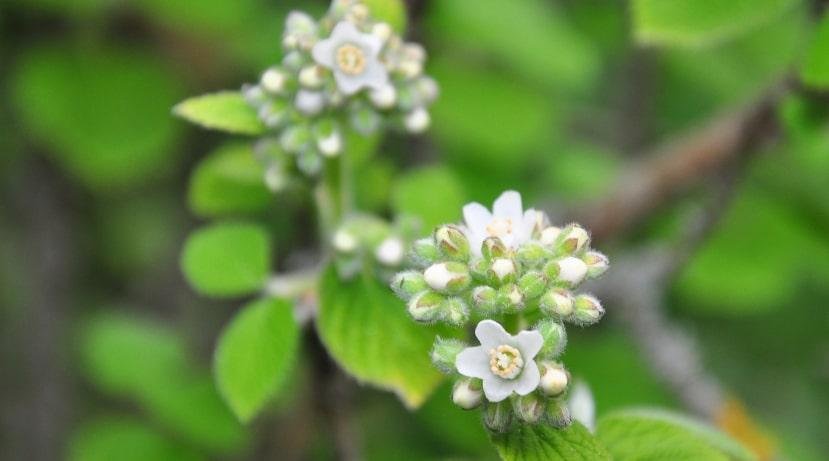
Scientific Name: Jamesia Americana
This bushy deciduous shrub, which can reach a height of two meters, belongs to the Hydrangea family. Underneath, the leaves are hairy and coarsely serrated. In late April, it has fragrant, waxy white or pink blooms on panicles. They are an excellent addition to cottage gardens, but they require well-drained soil.
101. Common Lilac
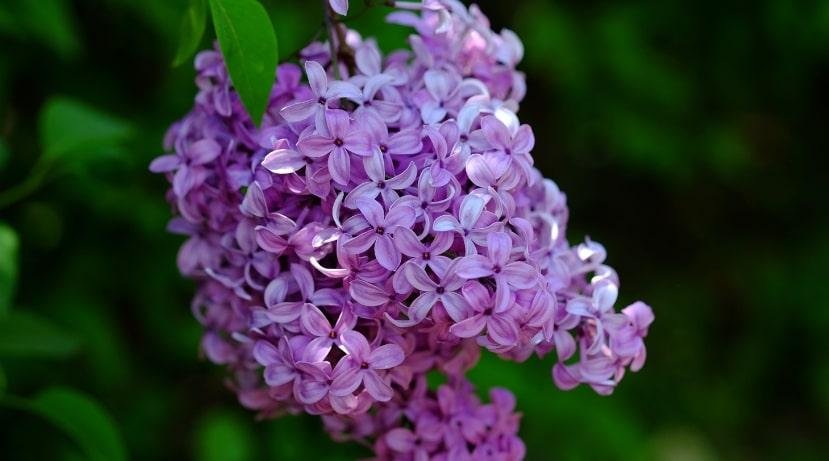
Scientific Name: Syringa vulgaris
This deciduous shrub is regarded as one of the best shrubs for flowering. Common Lilac is the most prolific bloomer, with an estimated four weeks of continuous blooming in late spring. Flowers come in a range of pastel colours and produce a fresh scent. They are frequently used as hedges or screens and can reach a height of 15 feet.
102. Creeping Mazus
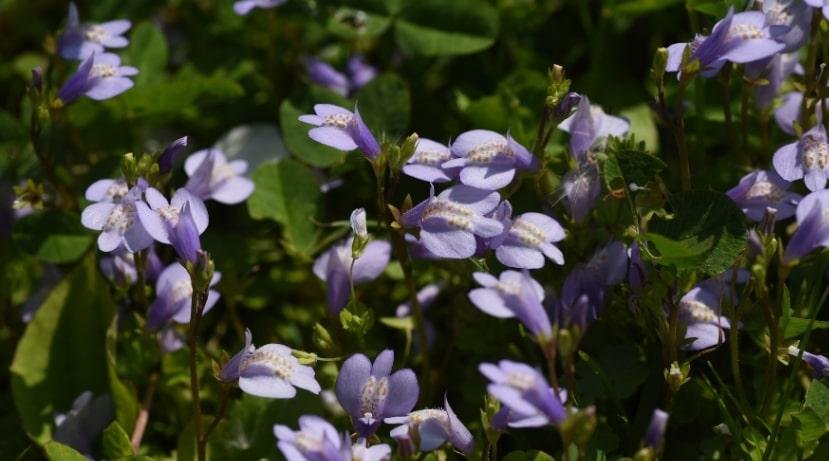
Scientific Name: Mazus reptans
This perennial plant is semi-evergreen and blooms from late spring to early summer with rocket-shaped blue to purple flowers. The white and yellow patterns encircle the centre of the clusters of flowers that form. It looks good under planting shrubs, as groundcover, or in rock gardens. It requires full to partial shade and is native to the Himalayas.
103. Cyclamen

Scientific Name: Cyclamen persicum
Cyclamens comprise over twenty species. Because florists and retail stores carry this plant, it is commonly known as the Florists Cyclamen. Particularly in the winter months. From late autumn until early spring, this delicate tuberous annual bears fragrant flowers.
That is to say, they are excellent additions to any garden that needs some winter hue. They have reflexed petals with butterfly wings that emerge from leaves with heart-shaped patterns.
104. English Lavender

Scientific Name: Lavandula angustifolia
The leaves on this bushy shrub have a grey-green colour and an aroma. Long stems with short, compact spikes of fragrant pale to deep purple summer blossoms are produced by this plant.
It looks amazing when used as an edging for paths or hedges, but it needs well-drained soil. Plant this where you can enjoy the refreshing scent of summer. Sometimes warmer climates are better suited for French or Spanish lavender.
105. Fiddleneck

Scientific Name: Phacelia tanacetifolia
It is native to northwest Mexico and the southwestern United States. It is sometimes referred to as the Scorpion Weed. It is a beautiful addition to any garden and one of the greatest plants for bees.
It has an explosive appearance due to the clusters of bell-shaped flowers that range in colour from blue to lavender and have lengthy filaments. When conditions are right, they can bloom in late spring for up to five months. It’s a hardy annual that requires little care and grows largely pest- and disease-free.
106. Heartleaf Bergenia
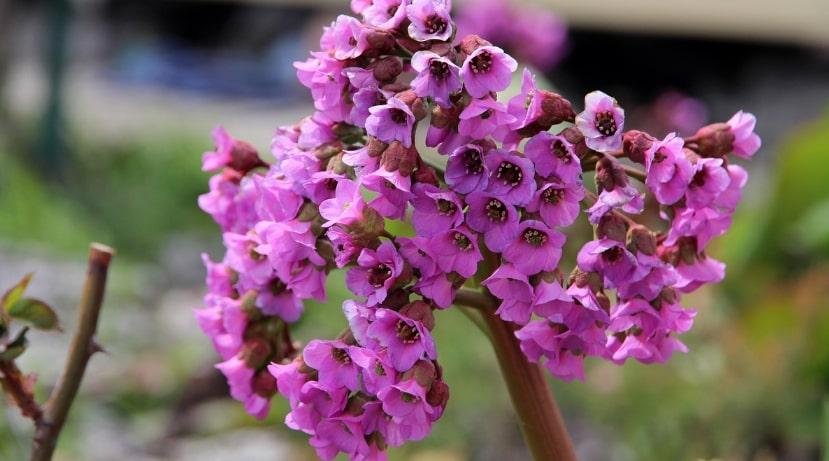
Scientific Name: Bergenia cordifolia
This evergreen perennial hailingF from Siberia is highly valued for its resilience and stunning deep-pink blossoms. Clumps form around them, and they are positioned above heart-shaped, leathery leaves that are used in floral arrangements.
Winter interest is enhanced by the foliage’s purplish-bronze hue. They look fantastic on banks and beds, especially in rock gardens, and require little upkeep. They develop readily under most circumstances.
107. King Protea

Scientific Name: Protea cynaroides
The Cape Artichoke Flower, as it is commonly called, is the national flower of South Africa. It’s an unusual-looking flower—some gardeners have even gone so far as to say it’s beyond unique. It is a highly valued evergreen shrub with enormous flower heads.
Every head has a core bouquet of tiny inner flowers encircled by vibrant bracts. Six to ten flower heads are produced by most plants. It needs the full sun.
108. Lenten Roses

Scientific Name: Helleborus orientalis
This flower, which is indigenous to the arid regions of Greece and Turkey, gets its name from blooming during the Christian season of Lent. This makes it an early bloomer for gardens that require a burst of colour following the winter.
This evergreen perennial looks great with its tiny saucer-shaped petals facing forward in a border. Up to 50 blooms per plant, lasting two months, are possible.
109. Majorwort
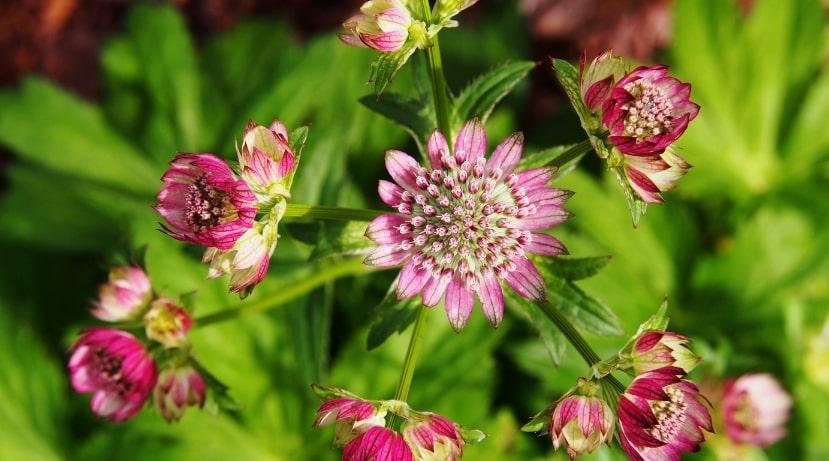
Scientific Name: Astrantia major
This perennial flower clusters tiny flowers together like pins on a cushion, creating strikingly coloured clusters. Its tidy form allows the blossoms to perch atop virtually black stems encircled by luxuriant foliage.
When conditions are right, it blooms in late spring or early summer and occasionally over the remaining part of the season. Sunny but cool climates with constantly wet soils are ideal. It grows easily and looks fantastic on borders.
110. Mountain Witch Alder

Scientific Name: Fothergilla major
This native of Southeast America is a deciduous shrub with a sluggish growth rate. Thanks to its exquisite bottle-brush white blossoms, it has earned accolades from the RHS. In the autumn, the green leaves turn orange, red, and purple-red.
It is nearly disease-free and spreads in an upright manner. To keep it looking its best, it needs full sun or partial shade.
111. Ohio Spiderwort

Scientific Name: Tradescantia ohiensis
The Ohio Spiderwort is a popular herbaceous perennial that is known for its vivid yellow stamens and clusters of three-petaled, typically blue (sometimes rose) blooms.
Each flower only lasts for about a day, yet during the six weeks that it blooms lavishly, it never runs out of flowers. This flower looks great in beds, borders, or cottage gardens and is rather versatile.
112. Alpenrose

Scientific Name: Rhododendron ferrugineum
This vertical evergreen shrub bears clusters of tubular rose-pink to scarlet blooms in addition to lustrous, dark-green foliage. It grows in an erect and compact style and blooms in the early summer.
The alpenrose, which reaches a maximum height of five feet, looks fantastic beside water gardens and at the back of borders. It is hardy in zones four through nine and loves full sun to light shade.
113. Amaryllis

Scientific Name: Hippeastrum
This bulb’s huge, vividly colored flowers on large stems make it a popular choice for gifts throughout the Christmas season. Amaryllis comes in five varieties: trumpet, cybister, tiny flowering, double flowering, and huge flowering.
The most common kind is the huge, single-flowering, up to 10-inch-tall Amaryllis. More stems and blooms are produced by larger bulbs. They are easy to get into bloom and can be planted outside (but only in the southern states). Reminiscent of candy canes, Amaryllis Clown is an old favorite and multiple award winners.
114. Bearded Irises
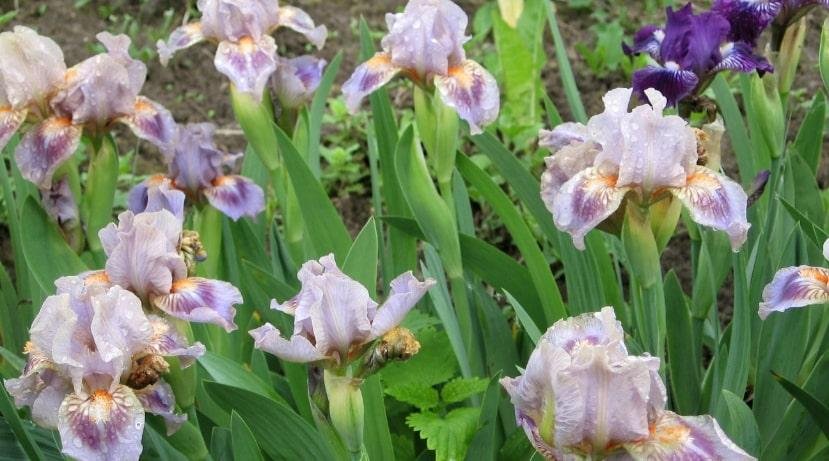
Scientific Name: Iris germanica
This genus is believed to have the showiest members, with thousands of variations and cultivars. Every bloom has three petals that stand erect, three petals that fall, and a frilled edge with a beard in the centre to direct pollinators. The majority of bearded iris blooms in the spring, with some returning in the summer and autumn. They are hardy in zones 3 through 10 and prefer full sun.
115. Bearberry

Scientific Name: Arctostaphylos uva-ursi
This evergreen shrub grows slowly and is quite resistant to winter weather. The glossy green leaves that turn reddish-purple in the winter are produced by the red stems.
It produces elegant clusters of white to pink flowers in the middle to late spring. After a few weeks, the blooms give way to vivid red berries, which feed birds and other mammals—including bears—a vital supply of nourishment for the winter.
116. Blue Passion Flower

Scientific Name: Passiflora caerulea
This RHS award-winning flower, also called the Common Passion Flower, is regarded as one of the most beautiful climbers. It is a strong climber with twining tendrils and is semi-evergreen.
Occasionally, from summer to autumn, the three-inch exotic-looking flowers appear, followed by orange fruits in the shape of eggs. It is simple to cultivate and thrives when left untidy, growing or drooping naturally.
117. Canada Violet

Scientific Name: Viola canadensis
Known by its common name, the Canadian white violet, and these perennial forms clumps. With its five delicate petals that have purple veins on some and yellow at the base, it is obvious that it belongs to the Viola genus.
The dark green leaves have a heart-shaped form. Canadian violets demand partial shade and self-seed profusely, but they look fantastic in forest or wildflower gardens.
118. Cranesbill

Scientific Name: Geranium wlassovianum
This is one of the hardy geranium kinds that blooms first and fades last, despite the abundance of variants. The rich purple, saucer-shaped flowers have white centers, darker veins, and attractive stamens.
The leaves’ ability to change colour—from purple to green to golden—makes them valuable as well. To enjoy their leaves and blooms, add them at the front of beds.
119. Dutch Hyacinth

Scientific Name: Hyacinthus orientalis
This plant, often referred to as common hyacinth, is widely used in gardens and bouquets across the globe. These are spring-flowering bulbs that have a wide range of colors, including black blossoms.
Plant them where you can enjoy the perfume they generate, as they have a deep, fresh scent. They look better in full sun than in partial sun, and their vivid green leaves provide great punch.
120. Everlasting Flower

Scientific Name: Helichrysum bracteatum
This summer bloom would look great in any yard and is genuinely joyful. It is a delicate perennial or annual with short flowering stems that resemble daisies.
The petals have a texture similar to stiff paper, and colors ranging from yellow to orange to pink to red to white surround the central yellow disc. Their name comes from the fact that they bloom from summer to autumn and, when dried, keep their colour and shape.
121. Gayfeather

Scientific Name: Liatris spicata
It is valued for its grass-like foliage and upright, fluffy flower spikes. It is also sometimes referred to as button snakeroot. The hues of the blossoms vary from white to rosy red to purple.
Over the course of four weeks, they bloom from top to bottom, and long after, they continue to provide seasonal interest and bird food. They grow easily to four feet in height and are hardy in zones three through nine.
122. Guernsey Lily
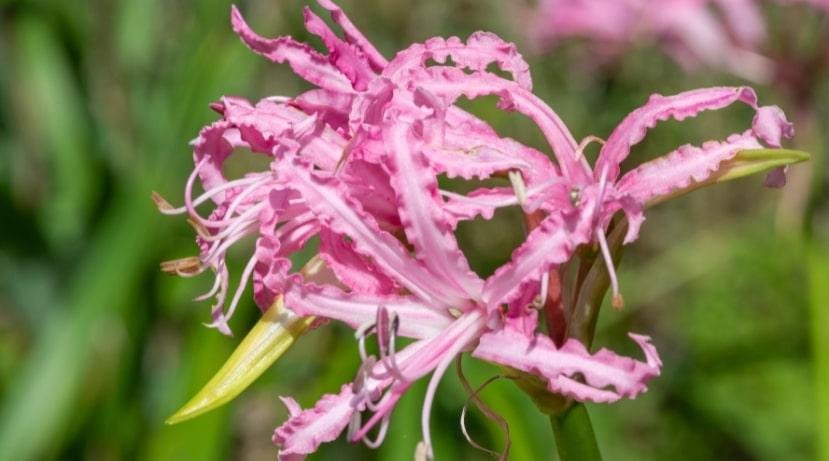
Scientific Name: Nerine sarniensis
This bulbous perennial, sometimes called the Spider Lily, bears enormous umbels of trumpet-shaped blooms. Bright scarlet, pink, or white flowers with wavy petals and golden stamens are displayed. They sparkle in the sunlight due to their iridescent gloss. Although they are only in bloom for a few weeks in the late summer, they give any landscape a hint of tropical fire.
123. Jacobs Ladder

Scientific Name: Polemonium caeruleum
This is an upright perennial that blooms in the spring and is recognised for its sprays of cup-shaped flowers that rest above rich green leaves.
This flower is also known as the Ladder to Heaven since its leaves have leaflets, and it can grow up to 24 inches tall. The flowers have long golden stamens and a vivid blue colour. They look fantastic on borders, beds, and containers.
124. Macedonian Scabious

Scientific Name: Knautia macedonica
This perennial herbaceous plant bears large clusters of pincushion flowers. They bloom from early summer to autumn, and they have a deep crimson colour.
This plant thrives in regions with cold summer evenings and draws in a wide variety of pollinators. They are easy to grow and look fantastic in dried or fresh bouquets, as well as in other kinds of gardening.
125. Spring Blossom

Scientific Name: Jaborosa integrifolia
This perennial herbaceous rhizomatous plant belongs to the Solanaceae family, which is linked to potatoes. They originally came from South America. The white blossoms have a starfish-like appearance. Additionally, they spread widely and work well in rock gardens.
126. Sugarbowl Clematis

Scientific Name: Clematis scottii
This perennial herbaceous plant bears drooping, urn-shaped blooms. Usually dark violet, flowers can also occasionally be pink or white in hue. It has an abundance of blossoms from early spring to late summer.
The autumn colour is enhanced by the fluffy seed heads that emerge from the blossoms. Despite belonging to the Clematis genus, it does not vine. Rather, it looks fantastic in rock gardens and borders.
127. Texas Mountain Laurel
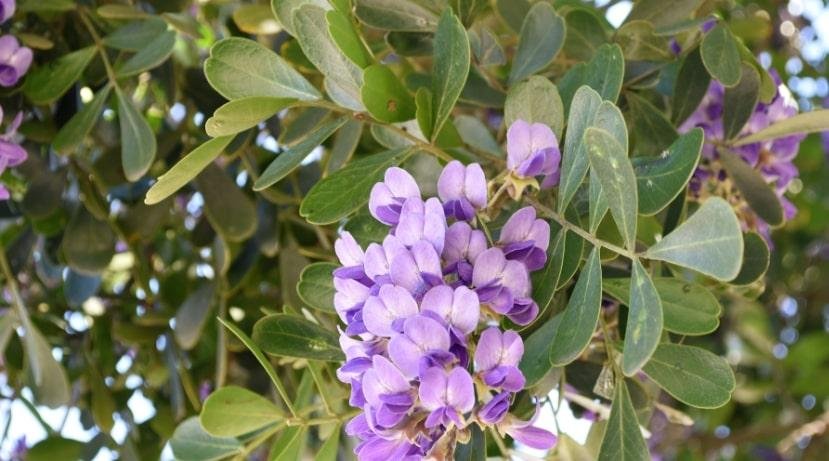
Scientific Name: Sophora secundiflora
You should make room in your garden for this flowering evergreen shrub for a number of reasons. It produces incredibly fragrant, swaying clusters of vividly colored blue to purple flowers in the spring. Their scent is comparable to bubble gum or grape soda.
Bees, birds, and butterflies are drawn to them. It also yields seed pods after blooming, which look like Christmas decorations on the tree. Growing up to 25 feet, it is incredibly resilient and looks fantastic as a street tree, patio tree, or screen.
128. Trumpet Vine

Scientific Name: Campsis radicans
This is a woody climbing vine that grows quickly and bears tonnes of beautiful flowers. At the tips of branches, clusters of blossoms emerge. They are three inches long, trumpet-shaped, and have vivid orange and scarlet hues.
Early to late summer is when trumpet vines bloom, putting on a vibrant display of Mediterranean hues. They look great on a trellis or arbour, but are careful planting them close to your home as they might damage nearby structures.
129. Winky Double Red-White

Scientific Name: Aquilegia vulgaris
This colorful columbine variety looks fantastic in containers as well as in the garden. It blooms from late spring to early summer, producing enormous bouquets of heavy flowers. It bears multicolored blooms that are red and white, and it has a bushy habit with strong stems.
This specific columbine is a Winky Series cultivar, distinguished by its unusual floriferous blossoms. Although they don’t last long, they self-seed to create huge colonies that look amazing in any kind of garden.
130. White Turtlehead

Scientific Name: Chelone glabra
This is an erect perennial that blooms in late summer and early autumn in spectacular spikes of two-lipped flowers. The name comes from blooms that resemble turtleheads and are either white or pink in tint. The spikes can reach a height of 36 inches and emerge from gorgeous dark green foliage. They thrive in drizzly areas and prefer medium to moist soils.
131. Toothed Aloha

Scientific Name: Nemesia denticulata
This endemic to South Africa is a mat-forming perennial that has won the RHS Garden Merit Award. Sometimes grown as an annual, it is a robust, semi-hardy perennial. From July to early autumn, it bears lovely racemes of light purple flowers with yellow throats. They resemble Snapdragons and are a great choice for first-time gardeners.
132. Tiger Flower

Scientific Name: Tigridia pavonia
This easy-to-grow bloom, often called the Mexican Shell Flower or Peacock Flower, puts on a stunning display in the summer. The enormous, flared blooms have contrasting dots and are two-toned and vividly colored, ranging from pink to red, yellow, orange, or white. Their maximum width is six inches.
Because there are so many stems, the flowering season lasts several weeks, even though each flower only blooms for one day.
133. Table Mountain Watsonia
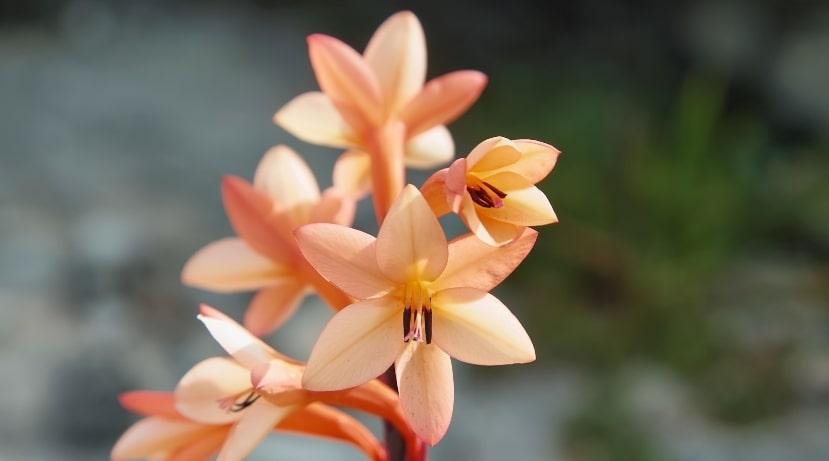
Scientific Name: Watsonia tabularis
Who declared that salmon was no longer a colour? This magnificent evergreen perennial yields spikes with twenty to thirty trumpet-shaped blooms on them.
The pink salmon blossoms stand out against the dark purple stems. When planted in huge clusters, they look fantastic and can reach a height of five feet. It’s a visually striking gift that all gardeners love, and it draws birds.
134. St. Johns Wort
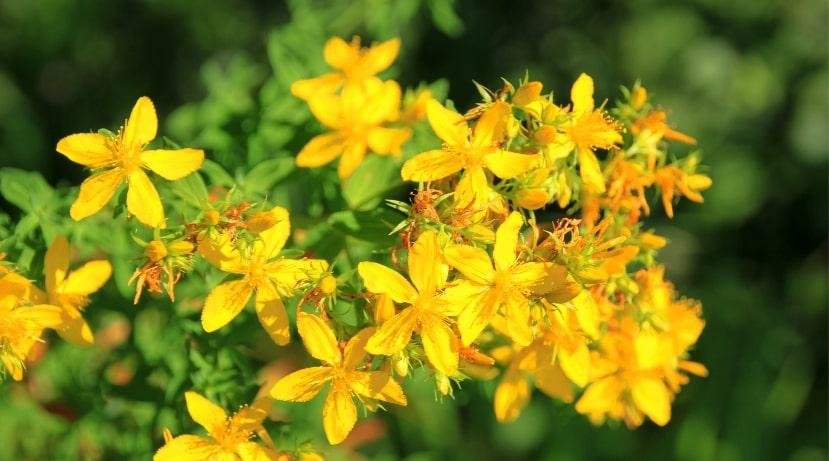
Scientific Name: Hypericum calycinum
This semi-evergreen shrub is the perfect choice if you want to create a carpet of golden sun in your yard from summer to autumn. It blooms so profusely that it nearly completely obscures the foliage. The bushy stamens topped with scarlet anthers on the rose-like blossoms lend remarkable beauty to any setting. It is a well-liked choice for ground cover and borders.
135. Roundleaf Liverleaf

Scientific Name: Hepatica Americana
One of the first wildflowers to bloom is this exquisitely delicate kind. It yields bowl-shaped flowers that range in colour from light blue to lavender. Because of their abundance of nectar, they are among the first food sources for a lot of pollinators.
It will gladly form a lovely groundcover in woodland or rock gardens as it grows to a maximum height of nine inches. When planting, go for a big visual effect.
136. Quesnelia

Scientific Name: Quesnelia arvensis
This bromeliad is indigenous to Brazil and belongs to the genus Quesnelia. It can reach a height of two feet and produces dark green, sharply pointed shooting leaves. In the middle, the quesnelia creates a white stem that is embellished with blue petals and a scarlet bloom.
It thrives in swampy forests and along the shoreline. It is the perfect accent for damp, muggy, and shaded spaces.
137. Pink Flowering Almond

Scientific Name: Prunus triloba
This shrub can occasionally grow into a small tree, bearing delicate, long stamens and white to pale pink flowers. When in full bloom, it transforms any landscape with gentle colour waves.
Although it originated in China, it is well-known worldwide. Curious artisans might want to consider making beaded bracelets from the fall-produced stones, which are a common usage for them in China.
138. Pig Laurel

Scientific Name: Kalmia angustifolia
In July, a bushy evergreen shrub with an abundance of deep-pink saucer-shaped blooms was awarded the RHS garden merit. The green throats have white stamens on them.
For more seasonal appeal, the beautiful blue-green foliage turns scarlet in the autumn. They prefer moist soils and partial shade. To encourage better flowers the following year, deadhead the blooms.
139. Ozark Sundrops

Scientific Name: Oenothera macrocarpa
Known by some as the Missouri Evening Primrose, it has slender, glossy leaves topped with enormous, fragrant, bright yellow blooms.
This perennial grows slowly, making it perfect for banks, containers, groundcover, and rock gardens. It blooms freely from late spring to early autumn; however, the flowers only open for a single day.
140. Moonflower

Scientific Name: Ipomoea alba
The way this flower blooms gives it its name—a beautifully odd one. In a matter of minutes, the blooms open in the dark and close as soon as the morning sun appears.
At night, the immaculate white blossoms display a faint green star and a faint fragrance. They are highly valued for filling trellises and concealing fences because of their large, heart-shaped foliage and quick climbing behaviors.
141. Love in a Mist
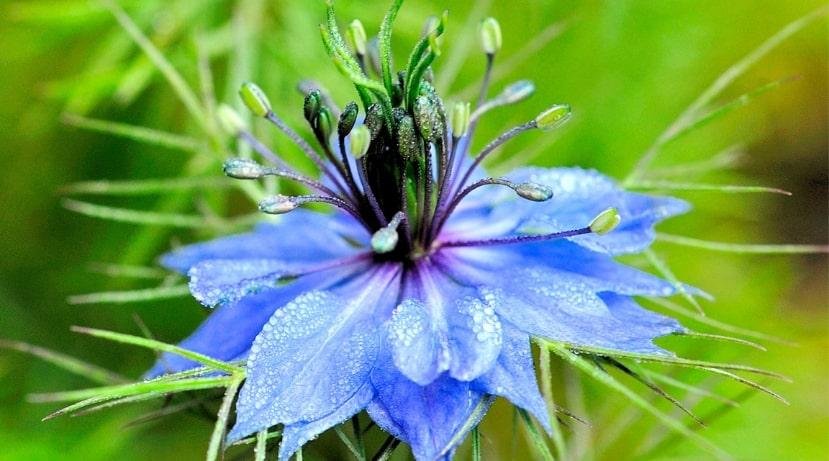
Scientific Name: Nigella damascena
This well-liked bushy annual plant has thick, spidery leaves that surround the blossoms in a mist of green. From early to late summer, the blossoms themselves are full of alternating purple flowers with green stamens. The balloon-shaped seed capsules that make beautiful cut flowers or garden accents take the place of the blossoms.
142. Kaffir Lily

Scientific Name: Clivia miniata
It is an evergreen perennial, sometimes called the Natal Lily that bears huge clusters of RHS award-winning flowers. They are funnel-shaped, orange to crimson in colour, and have a yellow neck.
There are 15 to 20 blooms in each cluster, which results in an enduring blazing show. This plant is ideal for containers as a focal point because it blooms most when it is pot-bound.
143. Japanese Toad Lily

Scientific Name: Tricyrtis hirta
This is an unusual option that yields hairy leaves encircling orchid-like flowers. This perennial prefers shade and grows along stream banks and on rocky cliffs that receive some shade.
They produce striking white to light purple flowers with a golden throat and hundreds of purple freckles. It is ideal to grow this flower in gardens with damp forests.
144. Honesty

Scientific Name: Lunaria annua
Soft, little lilac blossoms on this magnificent, tall biennial plant sit above the rich green foliage. These bloom in mid-spring for only a few weeks.
This plant is frequently called Silver Dollar because the seed heads that eventually replace them are flat, spherical, and colored silver. It looks great wherever it is planted, and it has won the RHS Garden Merit Award.
145. Freesias

Scientific Name: Fresia
The genus Freesia belongs to the Iridaceae family and is a perennial herbaceous flower. Five to ten trumpet-shaped flowers in various colors—red, pink, blue, yellow, and white—are produced by slender, arching stems.
They are planted mostly for cut flowers and are praised for their fresh aroma, but because of their vibrant colors, they may be found in any perennial border. They require well-drained soil and direct sunlight.
146. Daylily

Scientific Name: Hemerocallis
It’s common to refer to daylilies as the “perfect perennial.” This is because of their many colour options, ease of establishment, low maintenance requirements, showiness, and strong resistance to pests and drought.
With over 60,000 recognized cultivars, you have an abundance of options. Blooming time is one to five weeks, depending on the kind you choose and your climate. Though several species can rebloom, daylilies are called for their one-day blooms.
147. Common Gorse

Scientific Name: Ulex Europaeus
This shrub is evergreen and has a profusion of tiny yellow blooms. They bloom all year, reaching their peak in the spring, and have a coconut aroma. This plant is attractive, but it may be invasive in some places and is regarded as a fire-climax plant. i.e., it ignites easily in hot climates. However, many gardeners find it to be a hardy alternative because it can withstand freezing weather.
148. Candytuft

Scientific Name: Iberis sempervirens
This is a sophisticated choice because it’s one of the clearest white flowers you’ll discover in any garden. It is a low-growing perennial with a woody base that beautifies borders and edges for weeks in the spring and early summer. Big clusters of yellow-dotted white flowers stand out against the deep green leaves. In mild winter areas, it grows in bushy mounds and is evergreen.
149. Busy Lizzie

Scientific Name: Impatiens walleriana
In areas without frost, impatiens are herbaceous perennials; nevertheless, in other climates, they are regarded as half-hardy annuals. It’s among the most popular species of impatiens. The five-petaled blossoms are available in an array of hues. They are easy to manage, and they usually bloom from early summer until late autumn. Busy Lizzies are great hanging basket plants since they thrive in shade.
150. Aztec Lily

Scientific Name: Sprekelia formosissima
This delicate perennial bulbous flower is highly valued for its vibrant blossoms. They have three higher arching petals and three falling petals, and they are a vivid crimson colour, six inches broad. Aztec lilies sometimes rebloom in the autumn after their late spring bloom. In mild areas, where they are also evergreen, they can be left outside. They can reach a height of 12 inches and prefer full sun.
151. Lance-Leaf Tickseed

Scientific Name: Coreopsis lanceolata
This perennial herbaceous plant bears enormous, vivid yellow flowers that resemble daisies. A hint of red is added to the bloom by the darker stamen surrounding the yellow centre. Teethed petals rest over delicate stalks and soft foliage. They are heat, humidity, and drought-hardy, and pollinators adore them. Making them a simple choice to take care of.
152. Pot Marigold

Scientific Name: Calendula officinalis
This well-liked annual plant offers weeks of colour, usually from late spring until the first frost. This well-known plant is hardy in zones 2 through 11 and is native to southern Europe. Pot marigolds self-seed readily and non-invasively, and they grow quickly and are easy to manage. It yields white, yellow, or orange daisy-like blooms, occasionally with contrasting petal tips.
153. Southern Blue Flag

Scientific Name: Iris virginica
Even though we have highlighted a lot of iris, our guide also needs to include the Southern Blue Flag. This perennial yields tall stems that hold two to three violet-blue flowers each in the late spring. They thrive close to water and have a yellow mark on their veins. Wet gardens benefit greatly from the inclusion of this aquatic plant. Their sword-shaped leaves are stunning, and they can reach a height of 36 inches.
154. Sweetest Honeysuckle

Scientific Name: Lonicera fragrantissima
This is a climbing or bushy annual that is highly valued for its sweet, delectable scent. The charming pastel colors of the flower clusters are perched atop winged stems. They are lovely accents in any garden or area, with five petals that have a wavy appearance. They thrive in milder, more temperate areas and bloom from spring to autumn. Butterflies and bees also adore them.
155. Vipers Bugloss
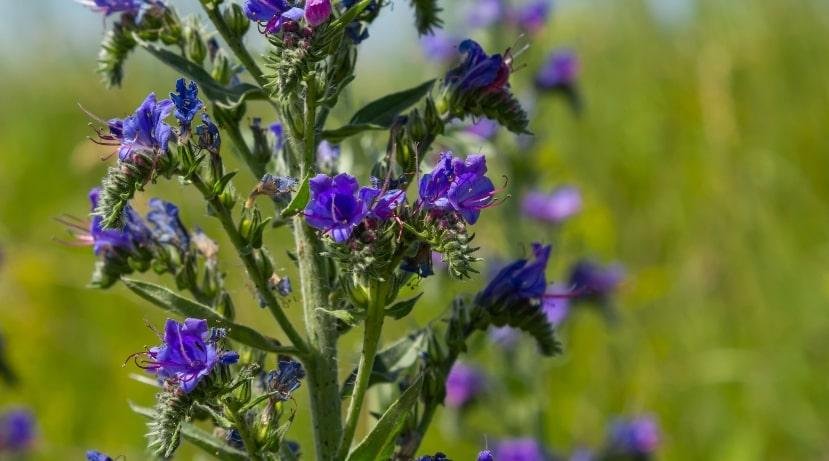
Scientific Name: Echium vulgare
This plant grows uprightly and can be either annual or biennial. It yields bell-shaped flowers in the form of cylindrical spikes, usually with pink stamens and a vivid violet colour.
It is native to Britain and can reach a height of 20 inches. Perfect for beds, borders, naturalized gardens, and cottage gardening. If you want to keep it under control, make sure to remove the flowering spikes after the season because it self-seeds readily.
156. White Dipladenia
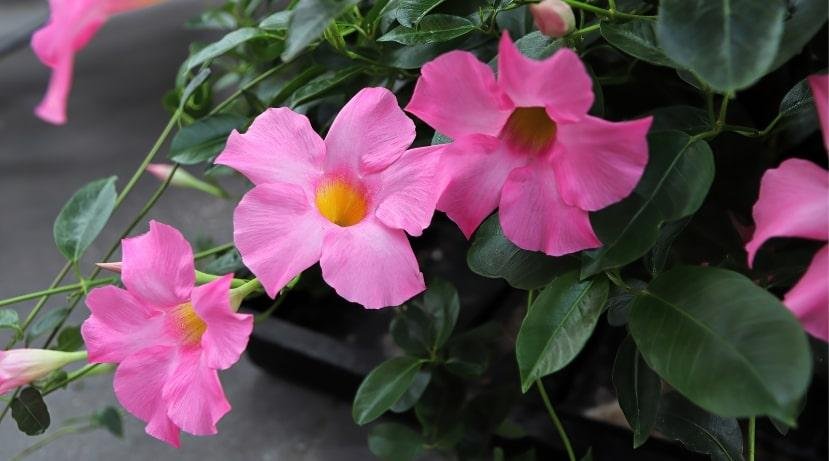
Scientific Name: Mandevilla boliviensis
This exotic vine, which is native to Bolivia, gives any garden a hint of the tropics. It produces up to seven funnel-shaped flower sprays throughout its summer peak.
The orange throats of the white flowers contrast with the glossy, dark green leaves. This best choice grows up to 10 feet tall and is great for trellises, pergolas, and containers. This tropical plant requires direct sunlight.
157. Yellow Toadflax

Scientific Name: Linaria vulgaris
This perennial plant has an erect structure and lots of yellow and white blossoms. They bloom from late April to the first frosts and resemble Snapdragons. It is classified as a weed since it readily self-seeds and is in the database of toxic plants. However, with the correct gardening care, it may produce lovely blooms in the broad sun.
158. Crown Imperial

Scientific Name: Fritillaria imperialis
This magnificent bulbous herbaceous perennial blooms in hanging, bell-shaped orange flowers. A crown of small leaves that resembles the top of a pineapple rests atop them.
They bloom for three to four weeks in the middle to late spring, reaching a height of up to 44 inches. Pollinators are drawn to the musk-like scent that these flowers emit, making them perfect for rear borders.
159. Fairy Duster

Scientific Name: Calliandra californica
This evergreen woody plant bears incredibly showy flowers that resemble feather dusters or pyrotechnics. Another reason gardeners adore them is that they bloom all year round, with a peak show from spring through autumn. The leaf has an erect habit and resembles ferns. It can reach a height of six feet and is nearly devoid of diseases and pests.
160. Fan Flower

Scientific Name: Scaevola aemula
Originating in Australia, this plant is relatively new to American gardens. They are constantly blooming from April into autumn. Often called the half flower, they have five petals fanned out in the style of a fan. With brilliant yellow and white centers, the colors include blue, pink, purple, and white. They do not mind the salty seaside air, and they are drought-tolerant.
161. Globe Flower

Scientific Name: Trollius europaeus
This beautiful perennial blooms enormous, yellow, bowl-shaped flowers that bear a strong resemblance to buttercups. Starting in late April, they will offer a golden-coloured, radiant carpet. They look fantastic when planted in big clusters and enjoy moist settings. It is incredibly versatile, low-maintenance, and grows up to three feet tall.
162. Himalayan Blue Poppy

Scientific Name: Meconopsis baileyi
Unlike other flowers in the poppy family, this one is not a real poppy and needs specialized maintenance. It is highly valued for its blue blossoms, and although it is a transient perennial, it is deserving of a spot in your garden.
Large, cup-shaped blooms with striking orange stamens are present. Reaching a height of four feet, its preferred conditions are semi-shady spots with colder summers over warmer ones.
163. Lisianthus

Scientific Name: Eustoma russellianum
Native to warmer regions, this flower is found in northern South America, Mexico, the Caribbean, and the southern US. These are annual herbaceous plants that have beautiful funnel-shaped flowers on long, straight stalks.
They are available in every hue of blue, white, pink, and purple. Typically found in grasslands, it is a tiny genus. They are luxury-cut flowers since they can be difficult to grow.
164. Mexican Aster

Scientific Name: Cosmos bipinnatus
This medium-sized, half-hardy annual aster is also called the Garden Cosmos. But they self-seed and take years to reappear. The flowers are large and vividly coloured; occasionally, they have coloured patterns and tips. They look beautiful as a flash of colour in any garden and draw butterflies and birds. Plant them where there is protection from the wind because the stems break readily.
165. Nodding Wakerobin

Scientific Name: Trillium flexipes
It is a common perennial in the Midwestern US that forms lovely clumps of huge, heart-shaped green leaves. When it blooms in the middle to late spring, it truly shines. The flowers include a black centre, three huge white petals, and three thin green sepals. It is perfect for woodland and wildflower gardens and enjoys partial to full shade.
166. Ox-Eye Daisy
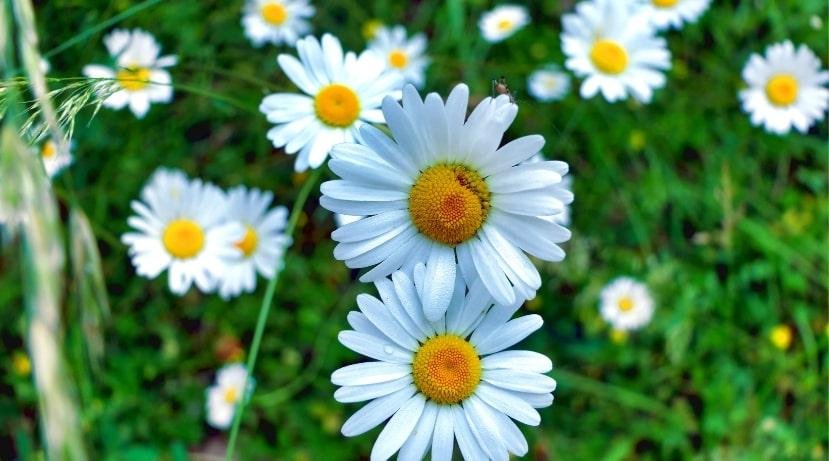
Scientific Name: Leucanthemum vulgare
This hardy perennial with copious blooms is well-known for its amazing display of flowers. You don’t need to seek much farther if you’re looking for a standard-appearing daisy with white petals and a sunny yellow centre.
They may reach a height of two feet and bloom for as long as six weeks. In locations with hot summers, they like shade and do well in full sun.
167. Paperbush

Scientific Name: Edgeworthia chrysantha
This deciduous shrub is bushy and grows up to six feet tall. Its smell and winter intrigue make it highly valued. Clusters of gradually coloured tiny flowers with white and yellow tones are produced by the bare stalks, and they can bloom for up to six weeks from late winter to spring.
Its name comes from the fact that it is used to manufacture fine paper in Japan. Evergreens that can withstand some shade look fantastic when placed there.
168. Red Torch Cactus

Scientific Name: Echinopsis huascha
This is a columnar cactus that can form clumps as large as three feet. The stems bear huge funnel-shaped flowers, usually red, orange, or yellow, from spring to early summer. The blooms can reach heights of four inches and widths of three inches. It grows best in full sun and dry times in between watering; it is hardy in zones 9 through 11.
169. Rock Soapwort

Scientific Name: Saponaria ocymoides
This semi-evergreen perennial that forms a mat and blooms for around three to four weeks is the recipient of an RHS award. Exuberant, vivid pink blooms blanket the majority of the olive-green leaves. It is perfect for these demands because it can climb walls and rocks with ease. It dislikes hot, muggy summers but grows easily in colder regions. In zones two through nine, it is hardy.
170. Sea Thrift

Scientific Name: Armeria maritima
Native to Great Britain, this evergreen perennial was once shown on the British lawn in the middle of the 20th century. It produces spherical clusters of pink, lavender, and white blooms on slender stems that grow compactly.
When they are happy and deadheaded, they bloom in the latter part of spring and occasionally in the summer. For the finest appearance, they want full sun and infertile soils.
171. Snowdrop Windflower

Scientific Name: Anemone sylvestris
The Snowdrop Windflower can reach a height of 18 inches and is a delicate late-spring bloom. The lovely blossoms are carried on slender stems that emerge from the dark green leaves.
The stamens are yellow, the undersides are pink, and the flowers are pure white. They grow well in full or partial shade and have a pleasant scent. These lovely blossoms make great groundcover or behind bushes.
172. Tall Verbena

Scientific Name: Verbena bonariensis
Lilac clusters of blossoms perch atop delicate, willowy stems that adorn this perennial shrub. They let the lance-shaped leaves on the ground do their job as they sat boldly and swayed in the summer breeze.
This RHS Award winner attracts butterflies and hummingbirds with its abundance of nectar. Early June is when it blooms until the first frost. It grows swiftly, becoming as tall as six feet.
173. West Indian Jasmine

Scientific Name: Ixora coccinea
Although it grows in many US subtropical areas, West Indian jasmine is a tropical plant that is often found in tropical Asia. In tropical regions, they bloom continuously.
Often called the Jungle Geranium, it bears enormous, domed heads filled with small blooms that bloom in vivid shades of pink, orange, yellow, red, or pure white. It’s a lovely, glossy shrub with evergreen foliage.
174. Tree Mallow

Scientific Name: Lavatera maritima
This sub-shrub is semi-evergreen and bears enormous, tropical-looking flowers that resemble hibiscus blooms. They have a light lavender hue that progressively gets darker towards the centre.
This shrub bears abundant summertime blooms, with occasional autumn blooms during the remainder of the year. This is nearly pest-free and a fantastic choice for a background plant.
175. Spring Starflower

Scientific Name: Ipheion uniflorum
This little perennial with bulbs belongs to the Amaryllis family. It bears blue, pink, and white flowers with six petals that resemble stars. Every petal is arranged in a line down the centre, which leads to the vivid yellow stamens.
One of the simplest bulbs for gardeners to plant, they have a pleasant aroma. Though they don’t last long, they look fantastic when planted in masses or beneath shrubs.
176. Spotted Zygopetalum

Scientific Name: Zygopetalum maculatum
This orchid is indigenous to Bolivia, Brazil, and the Peruvian highlands. It produces eight to twelve one-inch-wide blooms in the spring.
The bottom petal is white with crimson veins, while the top petals are green with irregular dark red dots. It is appealing and gives any area an air of exoticism. Keep it out of direct sunlight and moist, but not wet.
177. Snowy Angels Trumpet

Scientific Name: Brugmansia suaveolens
Wonderful pendulous trumpet-shaped blooms are produced by the tropical semi-evergreen shrub Snowy Angels Trumpet, an award-winning variety. From June to autumn, this plant bears pure white blooms; however, some species’ trumpets are colored differently.
It is a great focal point for any garden and releases a lovely perfume in the evenings. They require full sun to flourish and are heavy feeders. This plant may have an angelic appearance, but if consumed, every portion is extremely dangerous.
178. Round-Headed Rampion
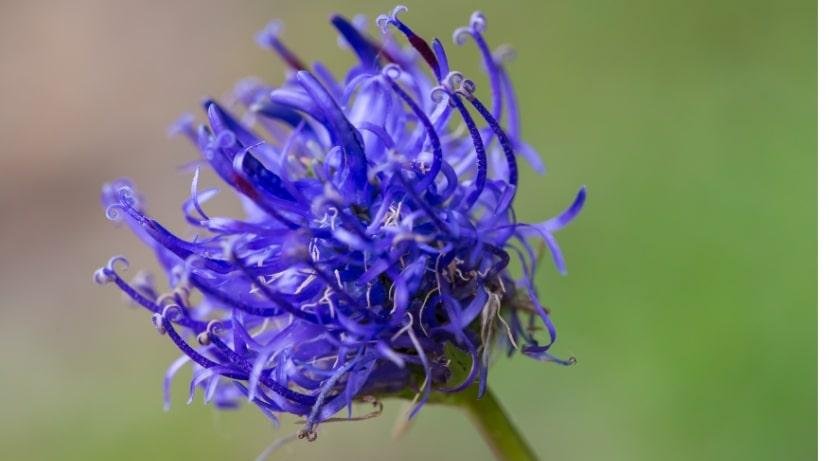
Scientific Name: Phyteuma orbiculare
This herbaceous perennial plant, which is also referred to as the Pride of Sussex, can reach a height of 20 inches. A rounded cluster of small flowers is produced by the erect stems that bear leaves of different shapes.
The flower heads are made up of tiny, blue-to-violet tubes with openings at the top that are occasionally dotted with white spots. To have the greatest visual impact, plant in groupings.
179. Red Valerian

Scientific Name: Centranthus ruber
This well-liked perennial draws pollinators, is resistant to pests and diseases, grows easily, and produces long, eye-catching blossoms. Making it a gardener’s firm favorite.
It has thick clusters of crimson star-shaped flowers and blue-green foliage that bloom from early summer to autumn. It looks fantastic as a border plant or in rock gardens, and it can reach a height of three feet.
180. Queen Annes Lace
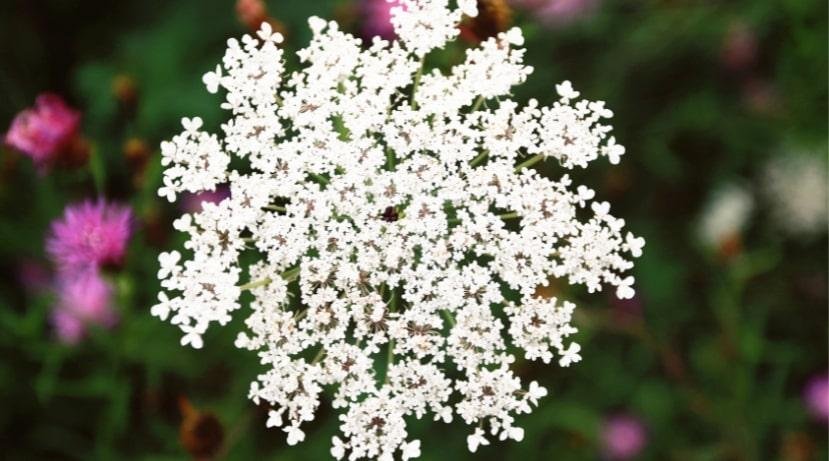
Scientific Name: Daucus carota
This is a three-foot-tall, white, blooming shrub that can occasionally be biennial. Stiff stalks bear numerous umbels of little white blooms.
Occasionally, they feature a tiny crimson core. When the root is young, it can be eaten, but as it ages, it becomes too rough. But it’s important to remember not to mix it with the lethal poison hemlock, as they seem quite similar.
181. Pineapple Lily

Scientific Name: Eucomis pallidiflora
This bulbous perennial, also called the Giant Pineapple Lily, has a distinctive appearance. Its common name comes from the fact that it is native to South Africa and resembles a pineapple. It produces racemes of white to green blooms that open in the summer. Pineapple lilies get their name from the heads of them, which can have up to thirty bracts each.
182. Paraguay Nightshade

Scientific Name: Lycianthes rantonnetii
Known by another name, Blue Potato Bush, it is a quickly growing shrub with thin, arching stems that are covered in yellow-centered, bright-purple blooms. Keep in mind that this plant is related to deadly nightshade, so avoid eating any part of it. This plant looks good with mixed borders and blooms from summer to autumn. For growth, it needs full light and soils that are moist but well-drained.
183. Oriental Poppy

Scientific Name: Papaver orientale
The spectacular blooms known as oriental poppies are worthy of a place in any garden. Large, silky-satin flowers with a darker centre are produced by them. The flowers are colored orange, red, pink, or white. Some have big seed pods, and some have petals with frills. They look fantastic in groupings and borders, and they can reach a height of three feet. Although they thrive in colder summers, they are hardy in zones three through eight.
184. Lily of the Valley
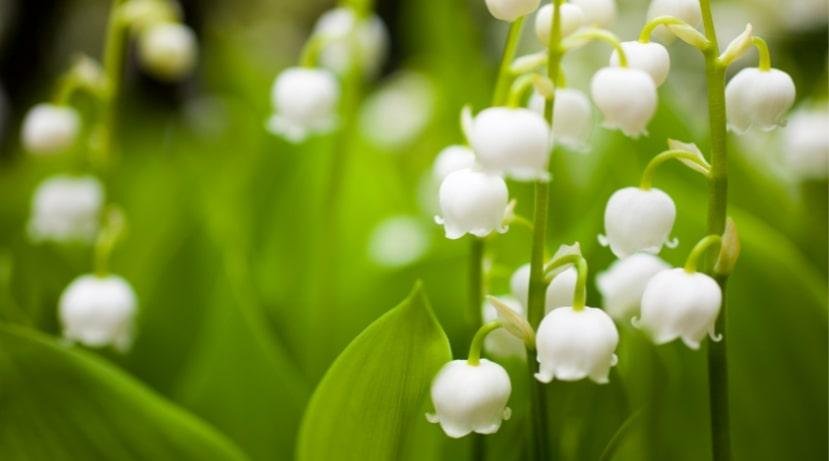
Scientific Name: Convallaria majalis
Shade is a thing that Lily of the Valley loves. This makes it a perfect complement to dark spots under shrubs or in shaded places where other flowers would not do well. This perennial grows slowly and has luxuriant, vivid green foliage. Up to fifteen bell-shaped flowers with a pleasant aroma adorn the arching stalks. This is a great cut flower for elegant arrangements.
185. Indian Blanket

Scientific Name: Gaillardia pulchella
This flower, often called the fire wheel, gives any landscape a dash of spiciness. They are striking wildflowers with daisy-like blooms that are native to the United States. Rich in nectar, Indian blankets bloom from late spring to autumn, drawing significant pollinators and birds who feed on the seed heads. They require little care and are robust and simple to grow.
186. Hollyhock
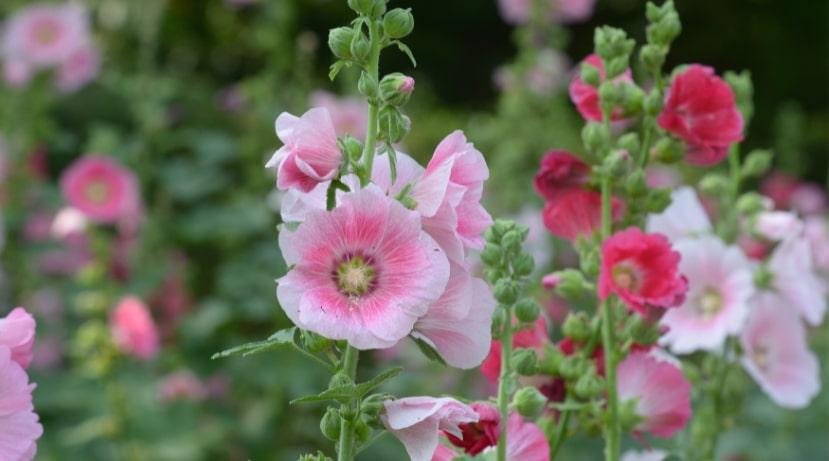
Scientific Name: Alcea rosea
Known by the name Common Hollyhock, this tall ornamental shrub looks fantastic in the back of any garden. It’s a strong perennial that lasts only a few years. It has enormous, funnel-shaped flowers in abundance and can grow up to two meters. Red, pink, purple, white, black, and bicolor are examples of flower colors. These are excellent for pollinators.
187. Great Blanket Flower

Scientific Name: Gaillardia aristata
This perennial wildflower has long-lasting blooms that resemble daisies. Thin petals that transition from crimson to yellow encircle the red centres. Birds value the seeded centres from autumn to winter, when they bloom from late spring to autumn. These chic flowers look amazing in pots, wildlife gardens, and rock gardens. They require not too much maintenance.
188. Fragrant Rondeletia

Scientific Name: Rondeletia odorata
Ironically, this plant, also referred to as the Panama Rose, has no perfume and hardly resembles a rose in appearance. Rather, it yields spherical clusters with several blooms. Each small flower has a deep yellow throat and five orange petals. It is a cheerful, candy-coloured accent to any garden that blooms for most of the year, drawing butterflies with it.
189. Daffodil

Scientific Name: Narcissi
Another common element in the landscapes of most gardeners is the daffodil. These are flowering bulbs that are well-known for their trumpet-shaped, usually yellow flowers. Twelve kinds make up the genus Narcissus, which includes a wide variety of species. All of them are simple to plant and come back every year. They greet spring and bestow cheery, vibrant blossoms upon our gardens.
190. Bluet

Scientific Name: Houstonia caerulea
This perennially blooming plant, often called Quaker Ladies, has small, delicate blossoms. The flowers are made up of four pale blue-tipped petals that progressively turn white with a yellow centre. This wildflower typically grows in small bunches at the base of huge trees, among mosses. It looks beautiful in a rock garden and requires sandy soil.
191. African Daisy

Scientific Name: Osteospermum
For those seeking vivid, exquisite flowers that last from summer into autumn, this is a great option. The Royal Horticultural Society (RHS) maintains a list of over 900 Osteospermum varieties, out of about 70 species, and a growing number of cultivars. A single flower with a centre disc and vibrant petals surrounding it is carried on a single stem. Certain species have the most exquisite bloom when their petals are varied in colour. While spoon-shaped petals are produced by some plants, including Osteospermum Sunny Philip, most petals are flat. A species’ status as an annual or perennial depends on the zone in which it grows.
192. Madonna Lily

Scientific Name: Lilium candidum
This flower has been used for 3,000 years and has a rich symbolic history. At ground level, it develops bulbs, and the stems can reach a height of around three feet. Summertime brings with it the blooms and their lovely scent. Their throats are printed in yellow, and they are completely white. Any landscape would benefit from this graceful lily as a focal point, so put it where you can appreciate its fragrance.
193. Mexican Bush Sage

Scientific Name: Salvia leucantha
Many people think that this evergreen shrubby perennial is one of the most beautiful salvias. It yields fluffy white flowers surrounded by purple sepals that are velvety attractive flowers. From late July until the first frost, they blossom atop tall spikes. It is great for borders or containers, and it grows up to six feet tall. The top fans are butterflies and hummingbirds.
194. Peace Lily

Scientific Name: Spathiphyllum cochlearispathum
Peace lilies are a flowering plant that is more often used indoors, but in zones 10 to 11, they can be grown outdoors in shady areas. It must be planted in complete shadow because it detests direct sunlight, even in brief bursts. Because of this, it’s a great choice for places with shadows where most other plants would wither away. Tall, lush green foliage with spoon-shaped spathes is produced by this plant.
195. Serbian Bellflower
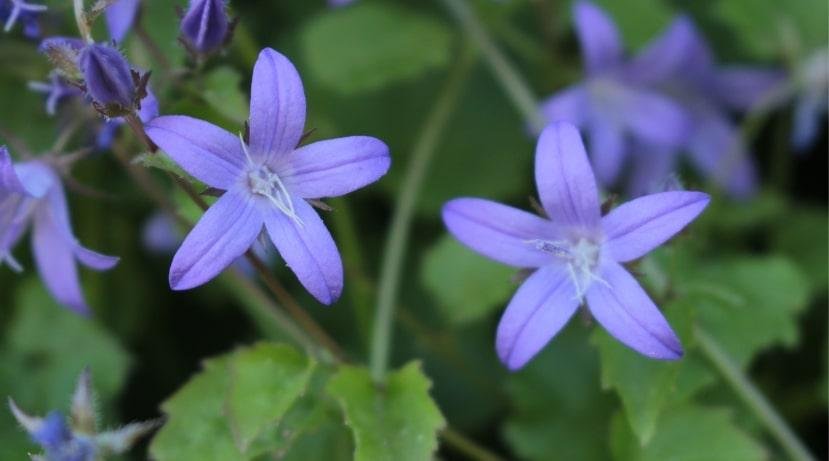
Scientific Name: Campanula poscharskyana
This sprawling perennial, also called the Trailing Bellflower, looks great spilling over walls or bordering borders and walks. It yields pale violet blooms in the shape of stars, with yellow stamens and a white throat. The beautiful green foliage of Serbian bellflowers is semi-evergreen, sometimes even evergreen in warmer climates, and they bloom copiously. It is simple to grow and gives any landscape a splash of colour.
196. Spanish Bluebell

Scientific Name: Hyacinthoides hispanica
Spanish bluebells is low-maintenance, disease- and pest-resistant bulbous perennials that make great additions to any garden. It yields robust stems with hanging bell-shaped blooms on them. Blooms might be lavender, pink, white, or violet-blue. They are perfect for forest gardens, rock gardens, and naturalized settings and grow well in either full sun or moderate shade.
197. Peruvian Lily

Scientific Name: Alstroemeria aurea
The Alstroemeria family contains several species, but this is one of the hardest. It is a tuberous perennial that has tiny, orchid-like flower clusters. Petals are speckled and striped, with colors ranging from orange to yellow to crimson. They add bursts of gold to your garden as they bloom from early to midsummer. They are good accent plants and can get up to three feet in height.
198. Perennial Flax

Scientific Name: Linum perenne
Linum perenne is a very delicate flower with tufts of short leaves and beautiful blue saucer-shaped petals that have white stamens and a golden throat. They have a one-inch diameter and can bloom for up to twelve weeks in late spring. It blooms profusely; however, the blooms only remain for one day. When grouped together, these blooms look amazing. It is easy to grow and perfect for your garden’s hot, dry spots.
199. Morning Glory

Scientific Name: Ipomoea purpurea
Prized for its stunning purple-to-blue colored trumpet-shaped blooms, this exotic climber annual is quite popular. The blooms close in the evening and open in the morning to reveal their white throats. Because of its rapid growth, this plant is perfect for hiding ugly trees or fences. In a single season, it can reach a height of ten feet! Butterflies and hummingbirds are drawn to it. Morning glory flowers come in a variety of kinds, each with a distinct colour.
200. Maltese Cross
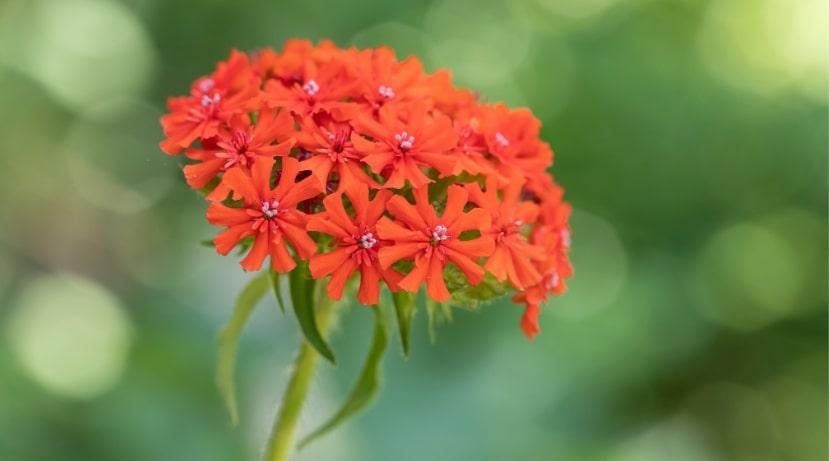
Scientific Name: Lychnis chalcedonica
This herbaceous perennial is attractive, easy to establish and manage, and offers long-term seasonal interest. Making it a gardener’s preferred choice. It develops erect stems on top of vivid green foliage. Bright, scarlet-colored flower clusters develop atop the stems. Plant where you need a splash of colour—in bright, wet locations.
201. Iceland Poppy

Scientific Name: Papaver nudicaule
Iceland Hardy yet transient perennials, poppies bear big, bowl-shaped blooms. Perched on shaggy, towering stems, they are surrounded by blue-green, fluffy foliage. They usually have red, orange, pink, and yellow blooms, and they have a mild scent. Iceland although they are not native to Iceland, poppies can withstand harsh weather in zones three through ten.
202. Groundcover Roses

Scientific Name: Rosa
This shrub rose spreads and trails and has glossy leaves and thorny stems. They bear abundant, thick clusters of fragrant, delicately colored single or double flowers in a range of colors. Groundcover Roses are great for covering slopes and banks that require a year-round burst of colour because they typically rebloom. They are resistant to disease and are among the simplest varieties of roses to maintain. “Flower Carpet Appleblossom,” “Sweet Drift,” and “Popcorn Drift” are excellent cultivar examples.
203. Gloxinia

Scientific Name: Sinningia speciosa
African violets and gloxinia plants have a similar appearance. They can be white, purple, pink, red, or blue, and their fringed petals frequently have a white border around them. These tropical perennials favour living in semi-shaded locations. Once the spectacular display fades, you will need to replant since they only bloom once in their life cycle. But the majority of Gloxinias that are sold nowadays are hybrids that only bloom again every few years.
204. Pearly Everlasting

Scientific Name: Anaphalis margaritacea
This perennial is bushy and has clusters of button-like flowers on top. Little golden disc centers are encircled by petals-like bracts that resemble white paper. It is a perfect partner for vibrant plants on any border, having won the RHS Garden Merit. It also works very well as a cut flower in dried bouquets. It blossoms from midsummer to autumn.
205. Showy Beardtongue

Scientific Name: Penstemon spectabilis
This evergreen perennial native to California produces a stunning display of wide-mouthed, two-toned flowers. Up to 100 blossoms can be seen on the upper half of leafy stems, which contrast with the green, leafy branches. They are fuss-free, grow quickly, and draw many helpful pollinators. Hardy in zones 8 through 11, plant in big clusters for a striking display.
206. Rock Purslane

Scientific Name: Calandrinia grandiflora
This succulent plant produces slender, evergreen, blue-green mounds of leaves. It produces long branches with huge, spectacular magenta flowers that bloom from spring to autumn. Although they are only open for a single day, you can never be without colour because they blossom abundantly throughout the seasons. Although it can be grown as an annual in colder climates, it is hardy in zones 9 through 11.
207. Siskiyou Lewisia

Scientific Name: Lewisia cotyledon
This beautiful evergreen perennial with a touch of charm for any landscape is an RHS Award winner. It grows easily and yields rosettes of dark, meaty leaves. In late April, it blooms vibrantly colored flowers with salmon pink, magenta, yellow, orange, and pastel pink petals. Typically, each petal has two tones, which adds to its allure. The plant, which can reach a height of 12 inches, looks fantastic in pots or rock gardens. In zones three through eight, it is hardy.
208. Four o’clock Flower

Scientific Name: Mirabilis jalapa
The trumpet-shaped blooms of this bushy perennial with brilliantly colored petals, usually in pink or red tones, are produced. They get their name from the way they blossom. Usually, these blooms bloom in the late afternoon and stay open until the next morning. Plant them where you can see and smell them, as they are fragrant. Be aware that they poison humans and animals.
209. Flowering Tobacco

Scientific Name: Nicotiana alata
One of the most extensively cultivated non-food commercial plants worldwide is this one. But because of its small, delicate blossoms and range of colors, it also makes a great ornamental blooming plant. The blooms are four inches wide, and they look great added to flower gardens. Among the most fragrant Nicotiana kinds, make sure to plant it in a location where you can enjoy its aroma.
210. Flannel Flower

Scientific Name: Actinotus helianthi
This is indigenous to the Australian wilderness that encircles Sydney. When gardeners discover that it belongs to the same family as carrots, the Apiaceae, rather than the daisy family, they are taken aback. It’s an herbaceous shrub with flannel-like (except for the petals) hair that is fine and fluffy. The delicate, white petals open up to bloom in the spring.
211. Feverfew

Scientific Name: Tanacetum parthenium
These are transient perennials that bloom copiously in the summer with tiny white blooms. Bloom forms can vary from circular balls to open daisy-like blooms, depending on the cultivar. They are excellent choices for cut flowers and ideal edging flowers, and they last for several weeks. The aromatic evergreen lacy foliage is also present.
212. Night-Scented Stock

Scientific Name: Matthiola longipetala
This expansive annual gets its name from its propensity for nocturnal flowering. The evening is when flowers unfold, releasing an intensely fragrant scent. The tiny, delicate blossoms range in colour from white to light violet. They are simple to grow and bloom from spring to autumn. Plant them where you can smell those best; containers and the edges of beds are good places to do this.
213. Perennial Sweet Pea

Scientific Name: Lathyrus latifolius
Known alternatively as the Everlasting Pea, this perennial climber has won numerous awards. It is a robust climber with racemes of up to eleven blooms that range in colour from white to rose pea. As they expand along the ground, they will look for neighboring plants or sturdy objects to climb. They reach up to nine feet in height and bloom all summer.
214. Rain Lily
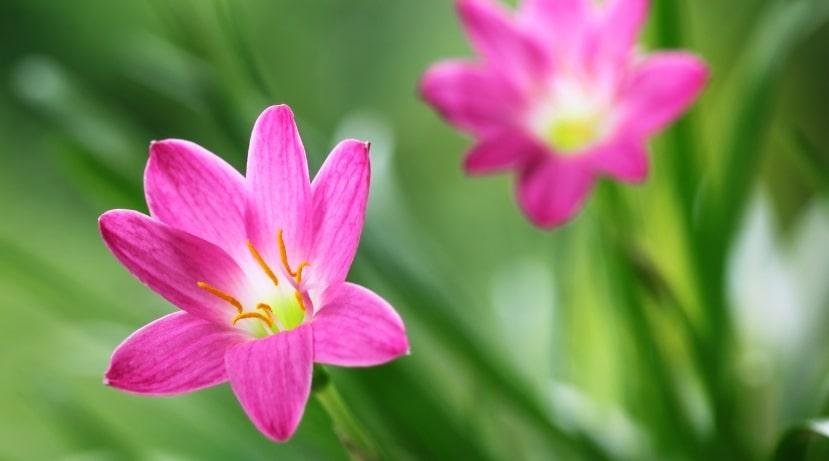
Scientific Name: Zephyranthes grandiflora
This perennial bulbous plant produces big, upright-facing, bright pink flowers. Like water lilies, rain lilies feature floppy yellow anthers and a white throat. One of the most popular species of rain lilies, they bloom for several weeks during the middle to late summer. Rain Lily look fantastic beside pathways where you can view them from above, in pots, or in rock gardens.
215. Slender Deutzia

Scientific Name: Deutzia gracilis
Among the roughly sixty species of Deutzia, this is one of the most well-known. They are perfect as a garden backdrop since they yield attractive flowers that can reach a height of three feet. In the spring, fragrant white flowers blossom. “Nikko” is a dwarf cultivar that is admired and awarded RHS awards; it is perfect for compact gardens.
216. Starry Eyes

Scientific Name: Nierembergia gracilis
This perennial evergreen can reach heights and widths of up to two feet. It is a plant that forms clumps and has dark green leaves. It almost always blooms in areas with high heat and humidity, providing months upon months of colour. The neck of the white, star-shaped blossoms is surrounded by delicate purple lines. This plant in a container looks great.
217. Wallflower

Scientific Name: Erysimum cheiri
This is a transient evergreen perennial that bears spikes topped with ten to thirty vivid orange-yellow blooms. The flowers have a pleasant aroma, and there are various cultivars with varying hues. They look fantastic in containers or at the front of borders, and they blossom in full sun come springtime. They are perfect for dried bouquets as well.
218. Bigleaf Lantana

Scientific Name: Lantana camara
This densely packed, vividly colored shrub bears clusters of narrowly spaced, colorful blossoms. Red, purple, orange, yellow, and white are among the available colors; these are frequently combined in one group. Giving colour to areas that seems lifeless. The blossoms give birth to purple berries after frost, which are devoured by birds and small mammals. There are additional cultivars that are dwarf and trailing.
219. Bluestar

Scientific Name: Amsonia tabernaemontana
This flowering perennial, also called blue dogbane has beautiful summer leaves that become golden in the autumn and bloom early. Clusters of the star-shaped flowers are perched atop robust stems. Bluestar is a great option for all American gardens because it requires little care, is resistant to pests and diseases, and is a native of the country. For it to grow, loamy, wet soils are necessary.
220. Cardinal Climber

Scientific Name: Ipomoea quamoclit
This delicate vine, sometimes called the Hummingbird Vine or Cypress Vine, grows quickly and vigorously. It’s perfect for covering up a harsh wall because it may reach a height of 15 feet in a single growing season. It produces foliage that resembles brilliant green ferns. From summer to fall, Cardinal Climbers produce one-inch-wide, tubular, star-shaped blooms. Hummingbirds and butterflies from all over the world are drawn to them by their rich nectar and vivid scarlet hue. It needs full sun and a sturdy object to grip.
221. False Rue Anemone

Scientific Name: Enemion biternatum
Remarkably delicate white blooms with petals clustering around the vivid yellow stamens are the hallmark of this woodland perennial. They grow into dense colonies that offer good ground cover. They are dormant in the summer, but in the autumn, new leaves emerge. They thrive in moist regions because they can withstand prolonged periods of rain and are found in woodlands and beside streams.
222. Fire Pink

Scientific Name: Silene virginica
This striking perennial bears clusters of thickly penalized flowers that are crimson in colour. When the sun hits their green, slender stalks, they radiate light like embers. These are sugary, nectar-rich wildflowers that grow in wooded areas. Hummingbirds are its main pollinators, and they need full to partial sun. Though fleeting, it creates stunning bursts of colour.
223. Golden Bell

Scientific Name: Forsythia suspensa
It is a big, deciduous shrub that can grow up to 10 feet tall and wide. It is also known as weeping forsythia. It yields a large quantity of vivid yellow flowers in the early to mid-spring. Adding much-needed colour to any garden following the winter. It works well as a screen and to provide height to buildings. It is renowned for its abundant blooms, low upkeep requirements, and general hardiness.
224. Garland Flower

Scientific Name: Daphne cneorum
A trailing evergreen shrub, the garland flower is recognized for its thick clusters of intensely scented, brilliant pink blossoms. Though they may flower in the summer when conditions are ideal, they blossom in the spring. There is a tone of ground colour since the blooms are so abundant that they cover the entire evergreen bush. It is an excellent choice for beds, borders, or rock gardens and prefers full sun to partial shade.
225. Licorice Root
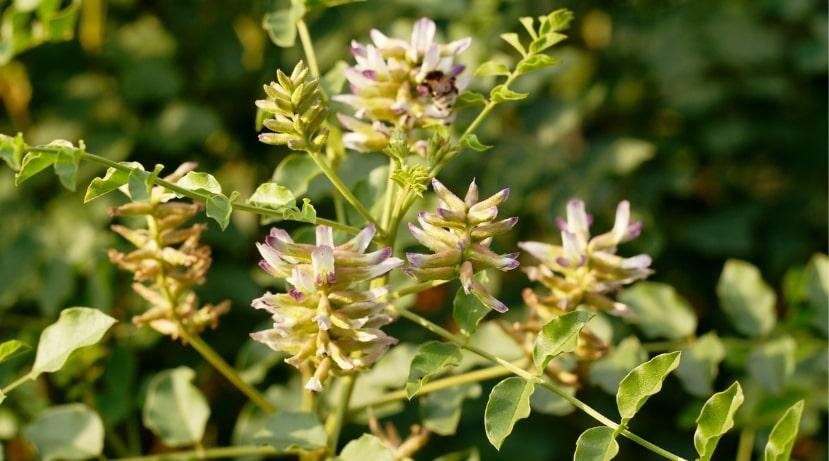
Scientific Name: Glycyrrhiza glabra
This perennial herbaceous plant has flowers and belongs to the family Fabaceae. The flavour of licorice originates from its sweet and aromatic roots, which are the reason it is commonly grown. It does, however, also yield stunning blooms that resemble erect cones. They give texture to any garden and range in colour from violet to purple.
226. Petunia

Scientific Name: Petunia
The genus Petunia comprises approximately 20 species, and it is a South American annual blooming plant. It is among the most widely used plants in gardens. This indicates that there are hundreds of varieties available, each with a unique colour and pattern. With the exception of frost, all grow tubular flowers that withstand a variety of conditions. They look fantastic in hanging baskets and on beds.
227. Red Hot Poker

Scientific Name: Kniphofia rooperi
This is one of the most beautiful of the about 70 species that make up the Kniphofia genus. It features enormous, egg-shaped flowers that turn yellow with time after being red at the top of the spike. The tall, thick, and imposing stems, which can reach a height of four feet, are perfect for creating vertical drama in your garden. Hardy in zones six through nine, these perennial flowers in late summer.
228. Sneezeweed

Scientific Name: Helenium autumnale
When most other perennials are beginning to wilt in the late summer and early autumn, this erect perennial begins to bloom. Slender leaves cover the tall stalks, which bear daisy-like flowers. Bright yellow petals encircle the projecting centre. They can withstand any type of soil, including extremely damp soil, and are resistant to disease. They appear stunning in borders and drifts.
229. Speedwell

Scientific Name: Veronica longifolia
This species, also called Long-Leaved Speedwell, is highly valued for its showy appearance and profusion of flowers. These long-blooming, low-maintenance perennials add vertical lines to the rear of any garden. Speedwells are available in white, pink, blue, violet, or purple hues and can reach a height of four feet. They are pollinators and require direct sunlight.
230. Bird of Paradise

Scientific Name: Strelitzia
There are five species of perennially blooming plants in the genus Strelitzia. The flower is referred to as the Bird of Paradise flower. In South Africa, where it originated, it is sometimes referred to as the crane flower. They yield a fan of petals in a variety of colors that are consistently vivid and striking. They require bright sun and well-drained soil to grow outdoors, and birds are their primary pollinators.
231. Firecracker Flower

Scientific Name: Justicia rizzinii
This bushy evergreen shrub, also called the Brazilian Fuchsia, has lush green foliage. Clusters of long, tubular, reddish-yellow blooms that resemble firecrackers can be found among the leaves. Since they are ostentatious, it is best to put them in areas where people can see them closely, like entryways or containers. The recipient of the RHS garden merit award requires moist soil and some shade.
232. Flame Nasturtium

Scientific Name: Tropaeolum speciosum
There are about 80 species of herbaceous-blooming plants in the Tropaeolum genus, both annual and perennial. This hardy herbaceous perennial cultivar is native to Chile. In order to get sunshine, it will climb over or through other plants. The funnel-shaped, crimson blossoms with clawed petals provide a dramatic display.
233. Wolfs Bane

Scientific Name: Aconitum napellus
Mid- to late-summer sees this flower’s spectacular spikes of blue ear-shaped blossoms emerge. Originally from the northern hemisphere, it requires full or partial sun. Known by several names, including Devil’s Helmet or Queen of Poisons, this poisonous plant must be handled carefully (and with gloves on!). Furthermore, it must be planted far from potential access points for kids and animals.
234. White Egret Orchid

Scientific Name: Habenaria radiata
This robust orchid yields beautiful blossoms that resemble a snowy egret in flight. The 1.5-inch-wide flowers are carried on an upright stalk and have two side petals that are fringed. For four weeks in late summer, a flower stalk can produce up to eight blooms. They are extremely uncommon and can be found in the grassy marshes of Asia, which makes them perfect for pond areas and bog gardens.
235. Urn Plant
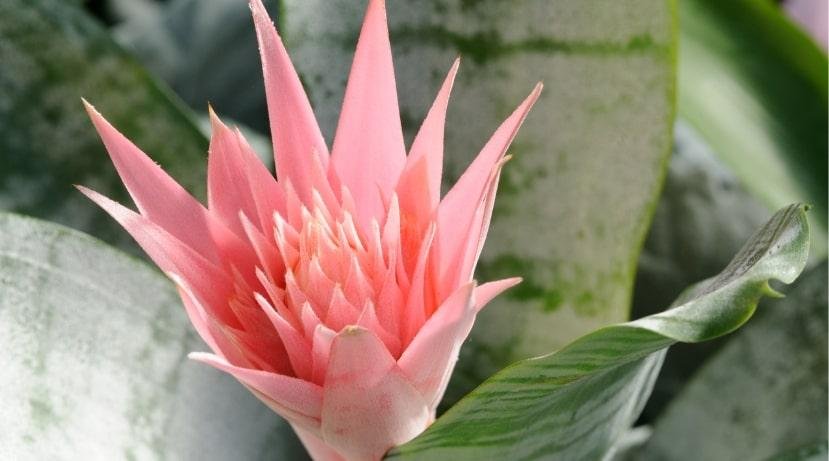
Scientific Name: Aechmea fasciata
This sensitive evergreen perennial forms an urn-shaped rosette of stunningly arching silver and green leaves. Three years later, the plant matures into a single spike of pure pink blooms, encircled by purple flowers and pink bracts. They only bloom once, but the show creates offsets and lasts for months. It requires some shade since it grows up to three feet tall.
236. Tulip

Scientific Name: Tulipa
Tulips can be divided into about 15 groups according to the size, type, and timing of their blooms. It was also challenging to select just one cultivar out of the several thousand available. They are a popular choice for garden bulbs and a representation of spring. You’re genuinely spoiled for choice when it comes to single or double heads, fringed or straight edges, and an array of colours. Typically planted as fragile perennials, their effectiveness starts to wane after a few years.
237. Treasure Flower

Scientific Name: Gazania
These are striking perennial flowers that bloom in daisyform. They have variegated petals, rings, dots, and black edges, but they are bigger. They come in bright hues like orange, yellow, pink, red, and white. Gazanias come in two varieties: trailing and clumping. They thrive in sun-baked garden locations where other flowers would wither because they like full sun.
238. Solomons Seal

Scientific Name: Polygonatum multiflorum
Due in part to its full shadow, this perennial does well in situations where others may not. It is, therefore, the perfect filler for empty spaces. It yields arched stems with tiny clusters of two to six tubular flowers with a creamy colour and a green tip. They are a valued ornamental option because of their graceful standing. Autumn foliage turns yellow, and blue and black berries replace the blossoms.
239. Rosinweed

Scientific Name: Silphium integrifolium
Don’t let the name’s reference to marijuana deter you. This wildflower resembles a happy sunflower. The sticky sap that seeps from broken stems is the source of its name. Since rosinweeds may spread quickly, it is best to put them in areas where they can do so, like meadows or wildflower gardens. It’s a tough, drought-tolerant shrub with bright yellow blossoms up to six feet in height.
240. Purple Mountain Saxifrage

Scientific Name: Saxifraga oppositifolia
This evergreen perennial, which forms a mat, is widely used in rock gardens and container gardens. In the spring, it produces a dense mat of small, dark green leaves that makes way for beautiful purple or magenta flowers. These blooms, with their orange anthers and dark throat, give a striking contrast to any garden. It is hardy in zones two through seven and is native to highland regions. It prefers partial shade in good soil.
241. Parrots Beak

Scientific Name: Lotus berthelotii
Native to the Canary Islands, this perennial evergreen trails after its host tree. The vivid scarlet blossoms are held in place by the trailing, needle-like silver leaves. The common name comes from the blossoms’ resemblance to parrot beaks, which provide an exotic touch to hanging baskets and containers. It detests hot weather and blossoms in the colder spring months.
242. Oyster Plant

Scientific Name: Mertensia maritima
This spreading perennial produces rosettes of blue-to-green, oval-shaped leaves. The leaves’ common name comes from their apparent oyster-like flavour. It bears clusters of bell-shaped flowers in late April. Pink-budded oyster plants open to a vivid blue colour while perched on branches. For seaside, rock, or cottage gardens, they are perfect. They like sandy soil and some sun, and they can grow up to six inches tall.
243. Obedient Plant

Scientific Name: Physostegia virginiana
The erect growth pattern of this herbaceous perennial is highly appreciated for its large spikes of tubular blooms ranging from lavender to pink. Its popular name, the Obedient Plant, comes from the fact that the spikes may be bent in any direction and remains in place. Hummingbirds and bees love it, and it blooms from summer to autumn. It grows well in full to partial sun and is hardy in zones three through nine.
244. Meadow Bistort

Scientific Name: Bistorta officinalis
This flowering plant is indigenous to portions of Asia and Europe. This herbaceous perennial can reach a height of 31 inches. Late spring until late autumn is when it blooms. Meadow bistorts bear racemes of pink to lilac blooms on upright stalks; the protruding stamens on each blossom give them a fluffy appearance. It needs moist soil and it will become dormant if not given enough water.
245. Basket of Gold

Scientific Name: Aurinia saxatilis
The RHS Garden Merit Award has been given to this slow-growing shrub. For up to six weeks, this evergreen perennial will cover your yard in a golden carpet of blooms. The grey-green foliage is also pleasing when it’s not in flower. Enjoys full sun but needs afternoon shade in warm areas. It requires little maintenance and gives pollinators nectar.
246. Chinese Pink

Scientific Name: Dianthus chinensis
This is a short-lived perennial or biennial bloom that is incredibly showy. It is highly valued for its strikingly contrasted flat petals of pink and white. Their dark central eye and heavy fringe lend a delicate beauty to any garden. The flowers are supported by thin leaves and stems. They work perfectly for containers, borders, and beds.
247. Black-Eyed Susan Vine

Scientific Name: Thunbergia alata
This is a beautiful, heart-shaped, occasionally variegated evergreen vine that twines. Lovely orange-yellow flowers with huge dark-purple throats float atop the leaves. Despite the wide variety of coloured varieties that are available, they bloom from the beginning of summer until the end of autumn, and they are well known for growing swiftly—they can reach heights of eight feet. Perfect for hanging in baskets, a trellis, or a harsh wall.
248. Hot Water Plant

Scientific Name: Achimenes longiflora
This beautiful plant, often called Mother’s Tears or Magic Flower, is related to the African violet. From summer to autumn, this perennial blooms for a considerable amount of time. Typically, petals have yellow throats and darker stripes, making them perfect for hanging baskets and other containers.
249. Chrysanthemum

Scientific Name: Chrysanthemum indicum
One of the most widely used flowers in bouquets globally is this one. It’s a showy flower that comes in many forms and sizes and is also referred to as the garden mum. Vibrant flowers are carried on multibranched stalks that emerge from dark foliage. Examples that have won awards from the RHS are “Ruby Mound” and “Grandchild.” Autumn is when they are most interesting, and they are an herbaceous perennial that needs full light. Mother plants are a favourite among gardeners of all abilities since they are simple to grow.
250. Fivespot
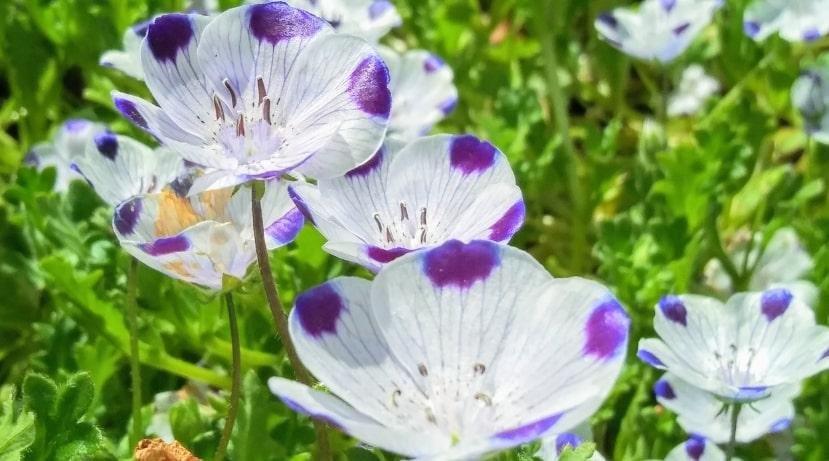
Scientific Name: Nemophila maculata
This little trailing annual produces white flowers in the shape of bowls. Its name comes from the five petals, each of which has a purple spot on it. Pollinators are unable to resist this annual because of its abundant blooms, which occur from mid-spring to mid-summer. Fivespot can withstand hot and muggy temperatures, but it grows more readily in cooler areas. This adaptable flower is hardy in zones 3 through 10 and perfect for hanging baskets.

